逻辑回归介绍
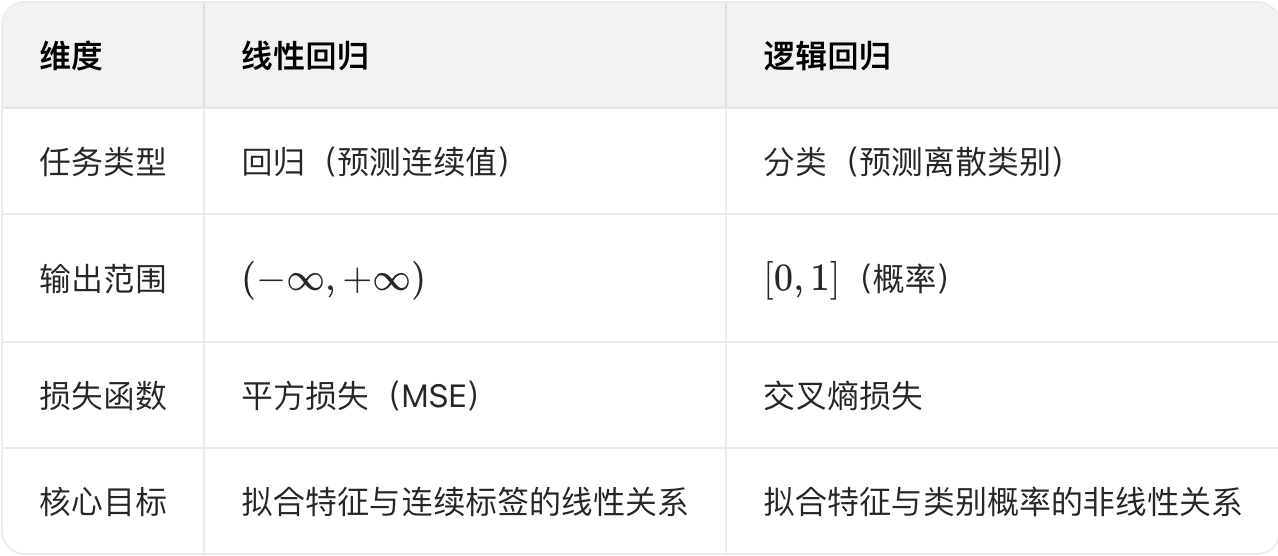
sigmoid函数
|
1
2
3
4
5
6
7
8
9
10
11
12
13
14
15
|
def
sigmoid(z):
"""
Compute the sigmoid of z
Args:
z (ndarray): A scalar, numpy array of any size.
Returns:
g (ndarray): sigmoid(z), with the same shape as z
"""
g
=
1
/
(
1
+
np.exp(
-
z))
return
g
|
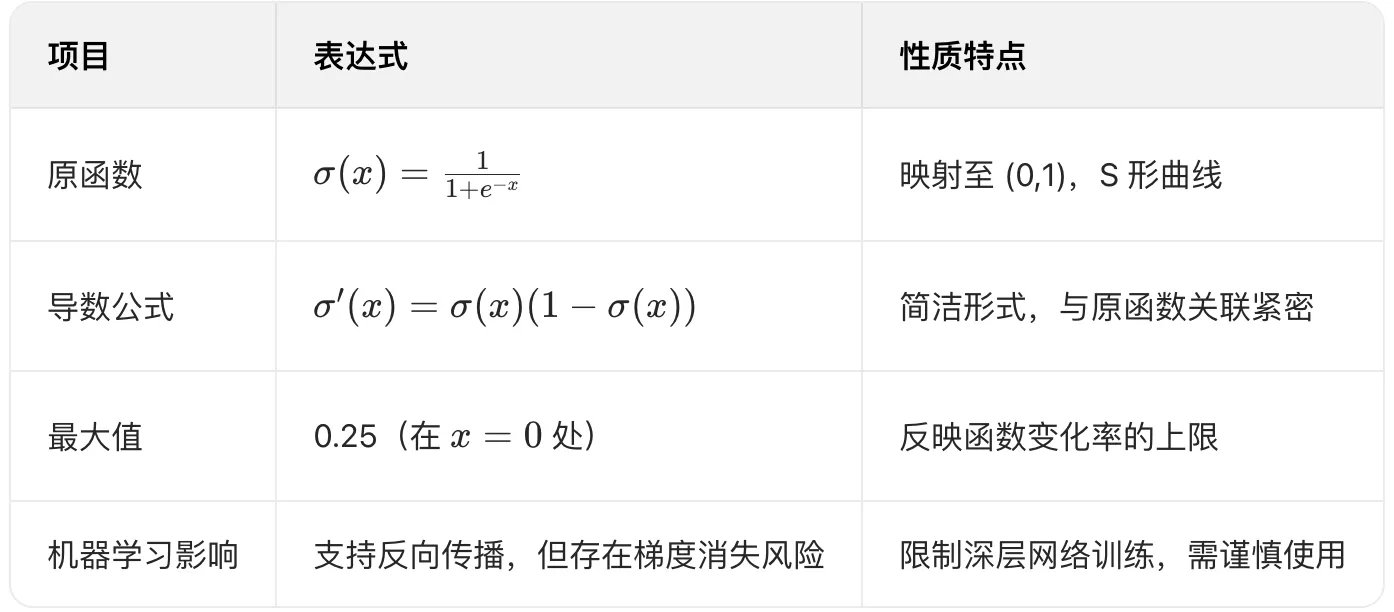
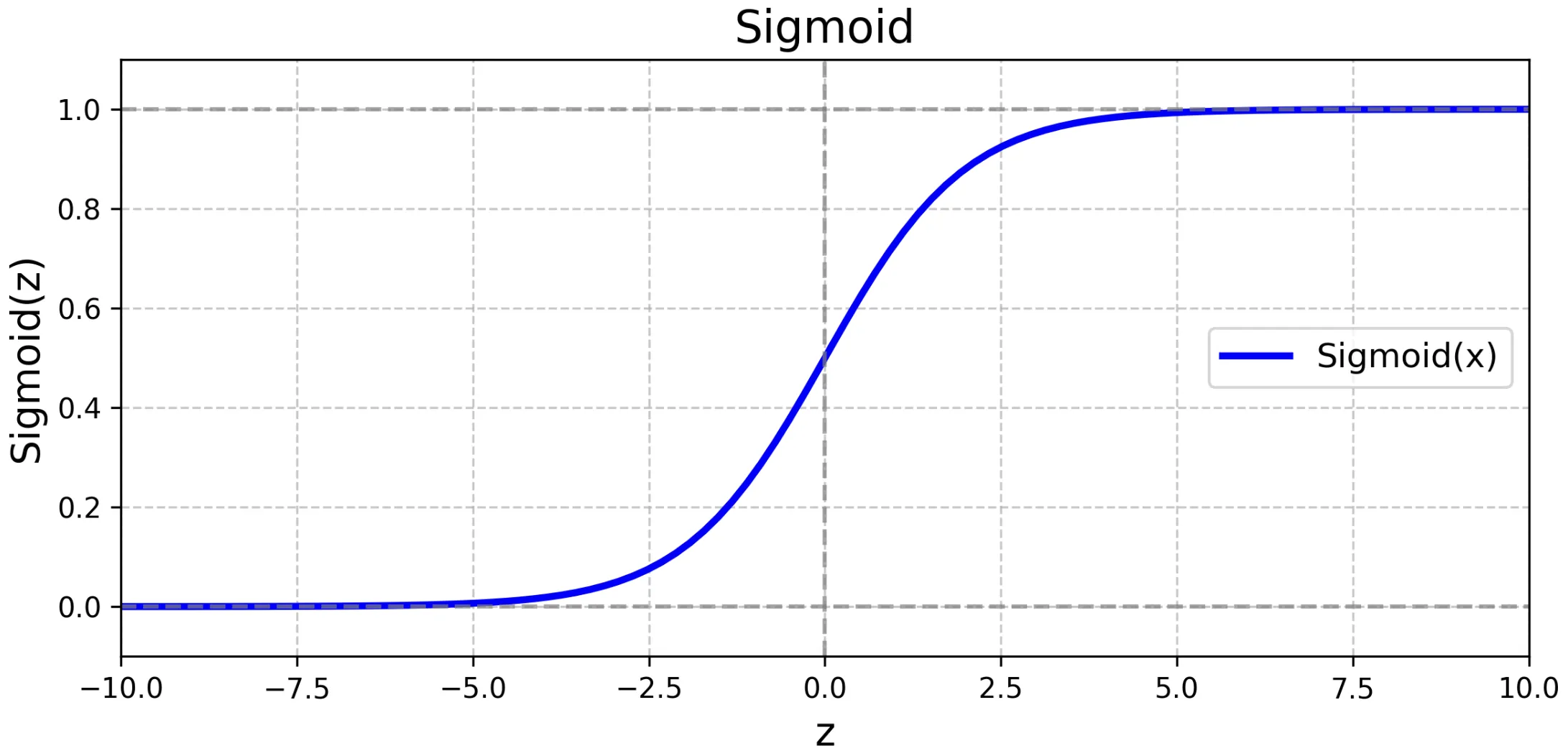
逻辑回归模型
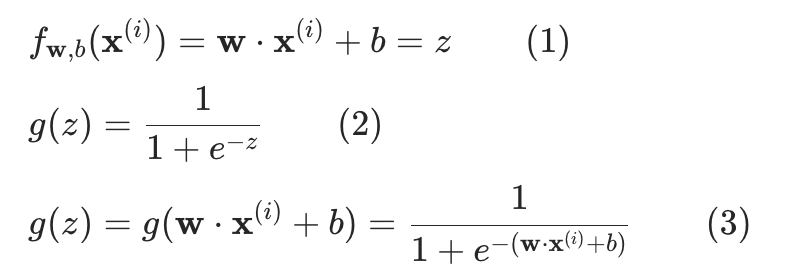
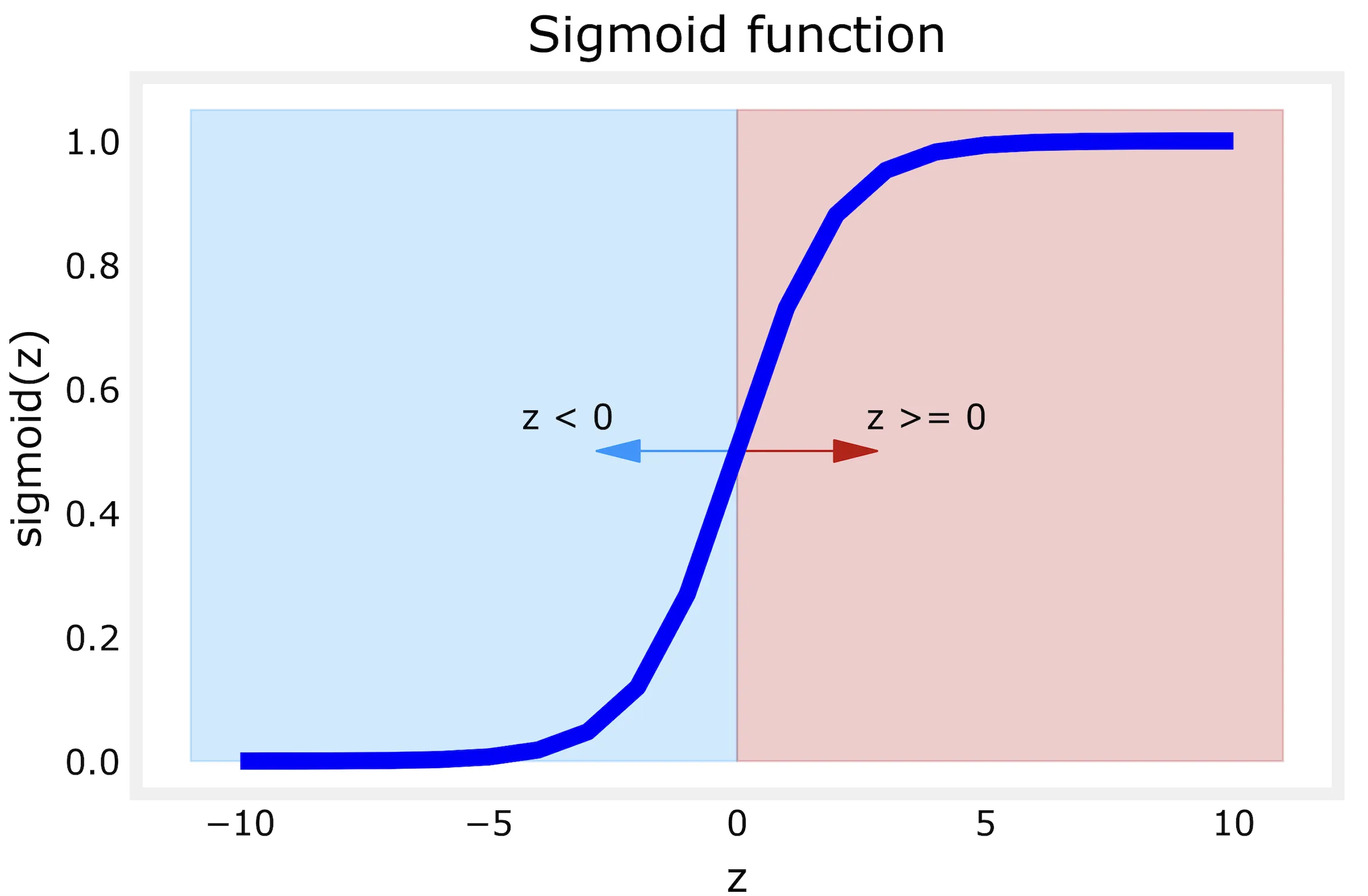
逻辑回归的决策边界
线性逻辑回归
根据sigmoid函数图象:z=0是中间位置,视为决策边界;那么为了得到决策边界的特征情况,我们假设:
- 线性模型
z = w1 * x1 + w2 * x2 + b - 参数
w1=w2=1, b=03,那么x2 = -x1 + 3这条直线就是决策边界
如果特征x在这条线的右边,那么此逻辑回归则预测为1,反之则预测为0;(分为两类)
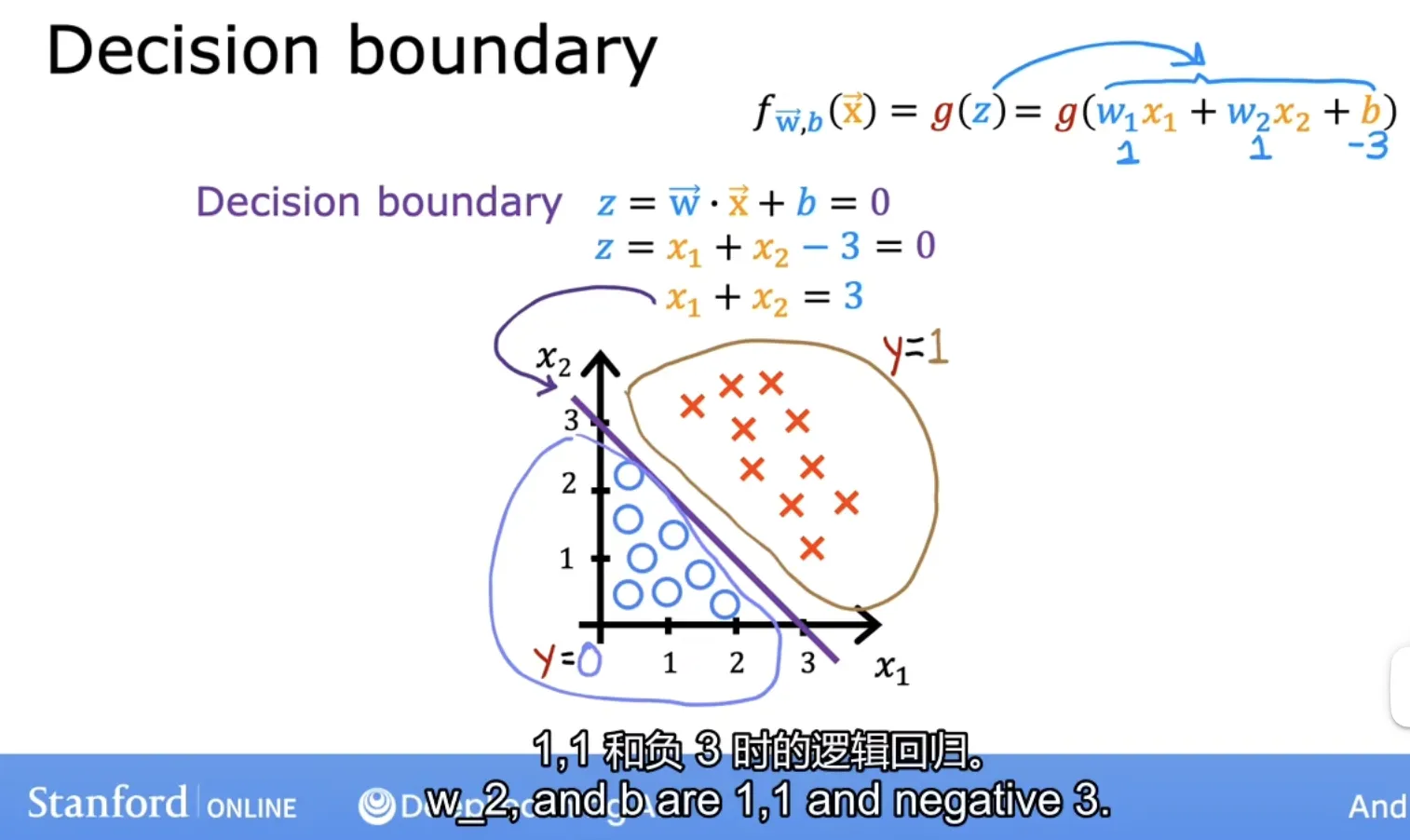
多项式逻辑回归
多项式回归决策边界,我们假设:
- 多项式模型:
z = w1 * x1**2 + w2 * x2**2 + b - 参数:
w1=w2=1, b=-1
如果特征x在圆的外面,那么此逻辑回归则预测为1,反之则预测为0;(分为两类)
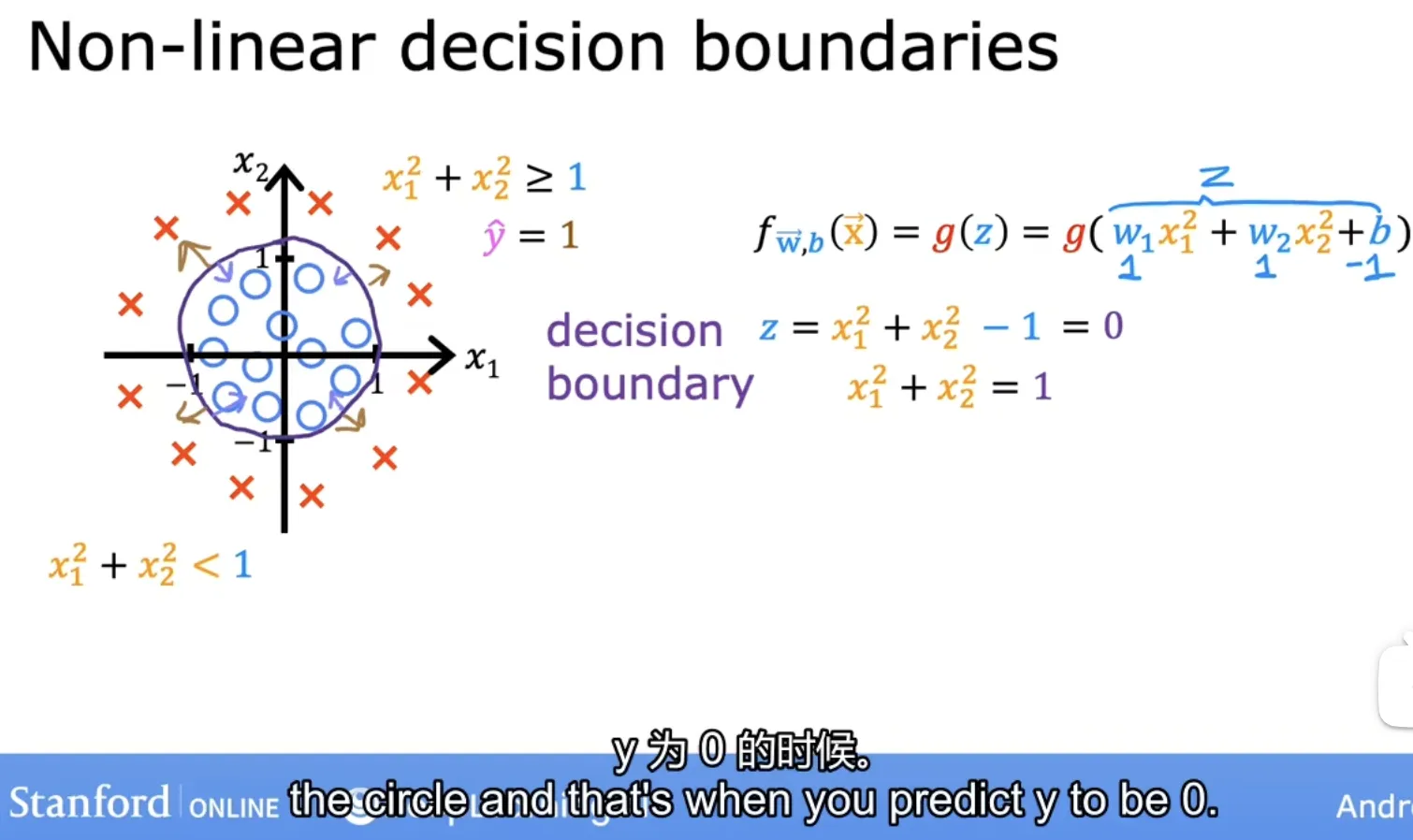
扩展:随着多项式的复杂度增加,还可以拟合更更多非线性的复杂情况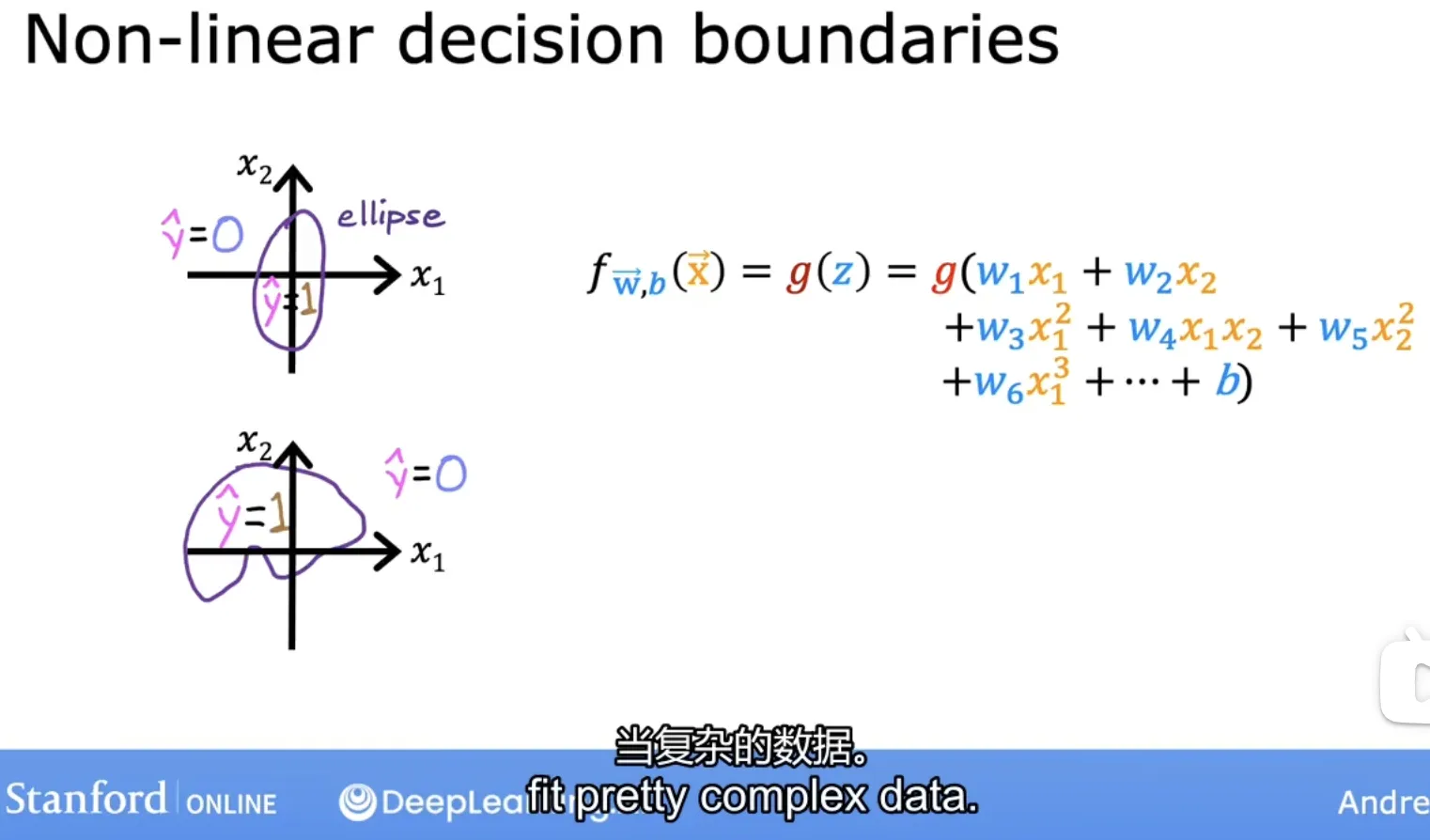
逻辑回归的损失函数
平方损失和交叉熵损失
回顾下线性回归的损失函数(平方损失):

平方误差损失函数不适用于逻辑回归模型:平方损失在逻辑回归中是 “非凸函数”(存在多个局部最优解),难以优化;
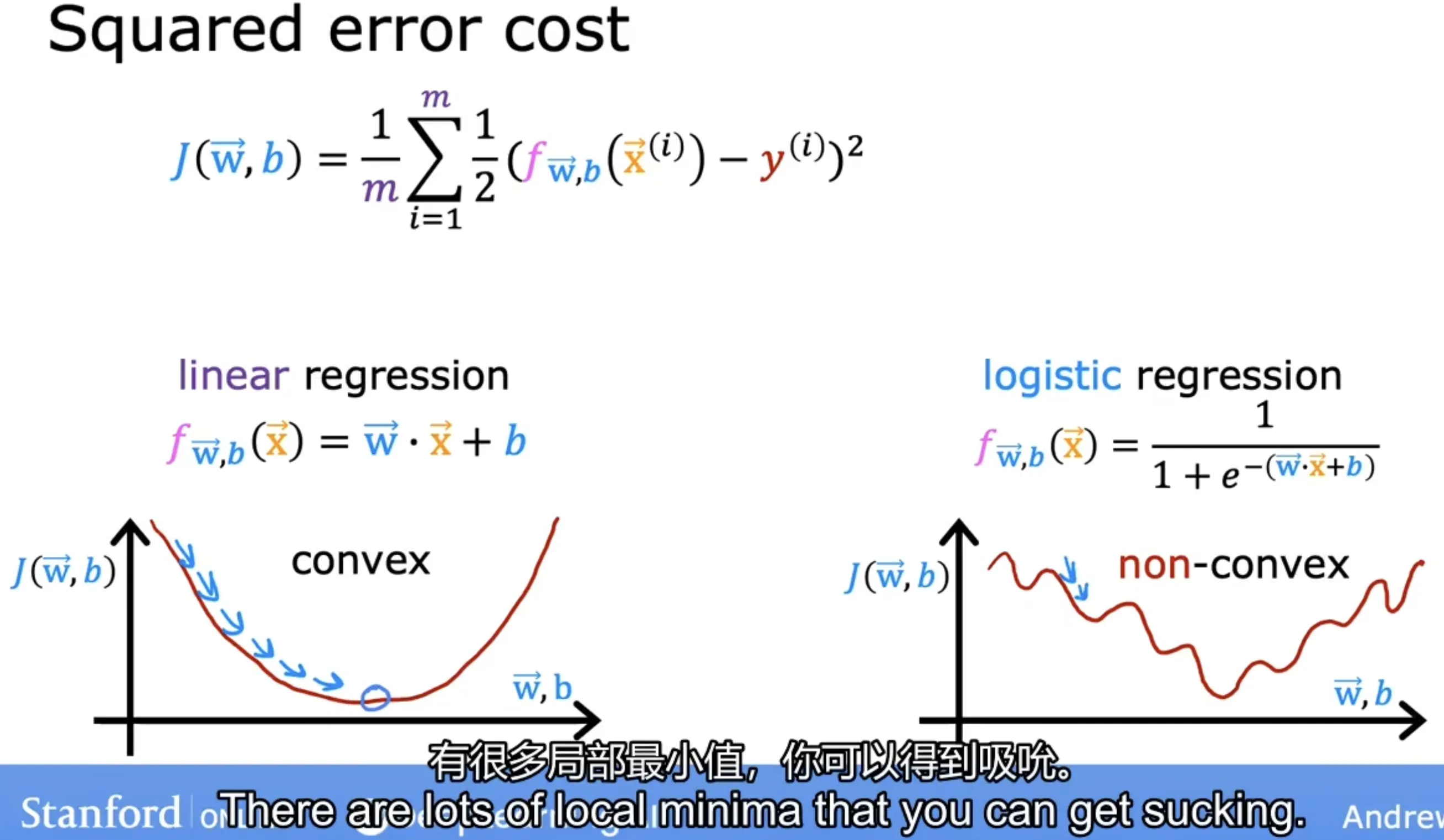
所以我们需要一个新的损失函数,即交叉熵损失;交叉熵损失是 “凸函数”,可通过梯度下降高效找到全局最优。
交叉熵源于信息论,我们暂时不做深入介绍,直接给出交叉熵损失函数公式:
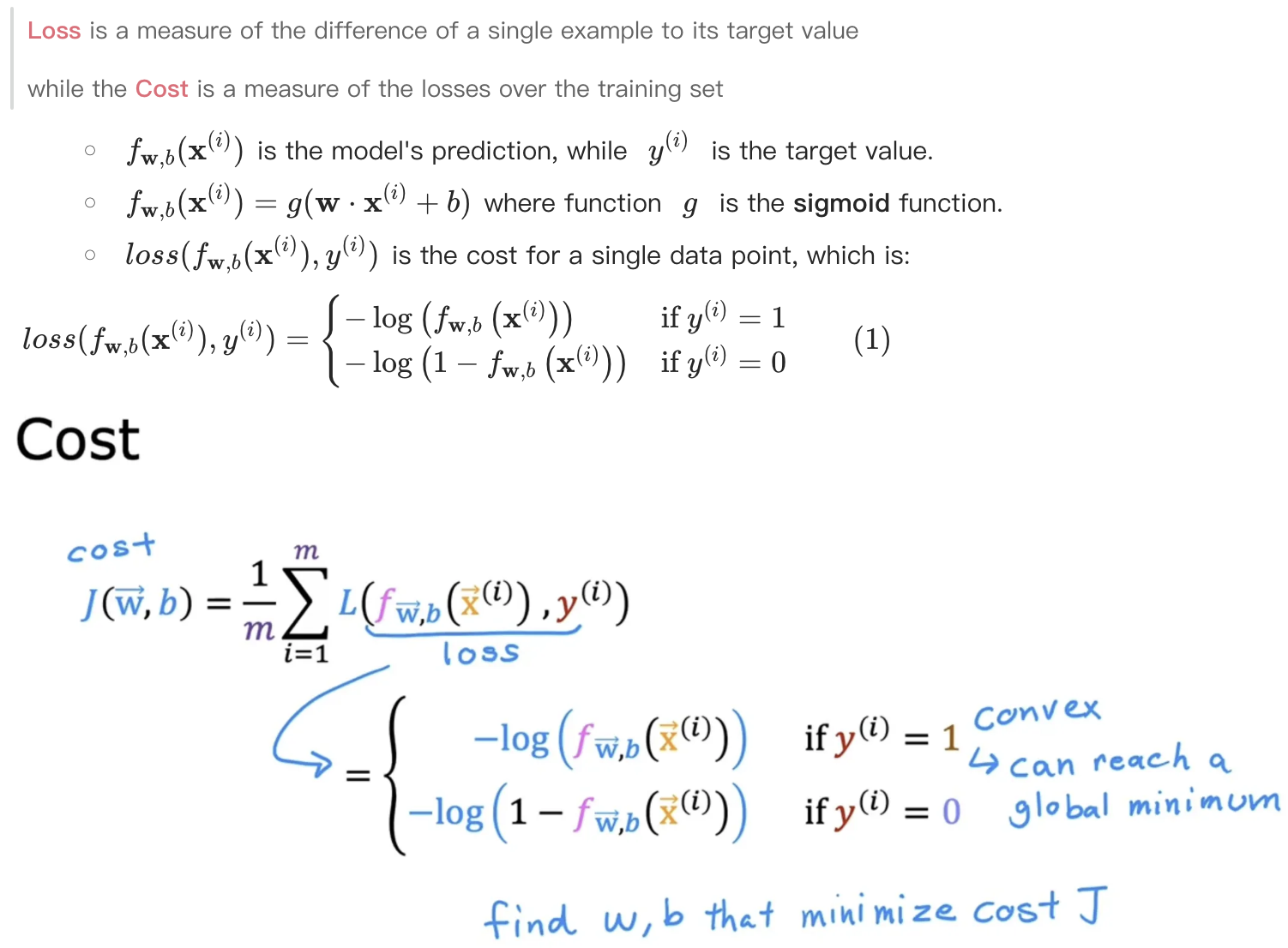
对数回顾
复习下对数函数的性质,以便理解为什么 交叉熵损失是 “凸函数”?
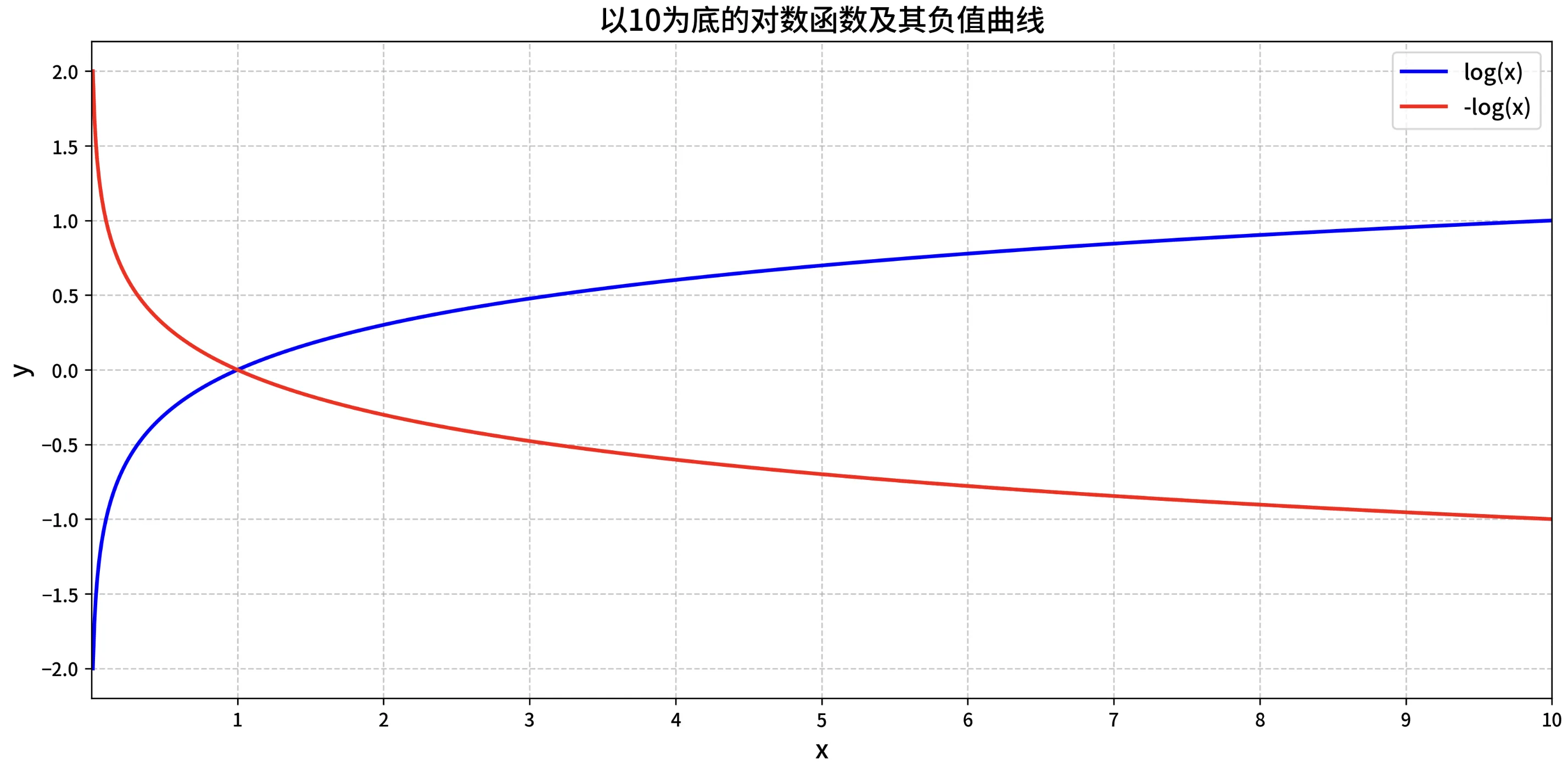
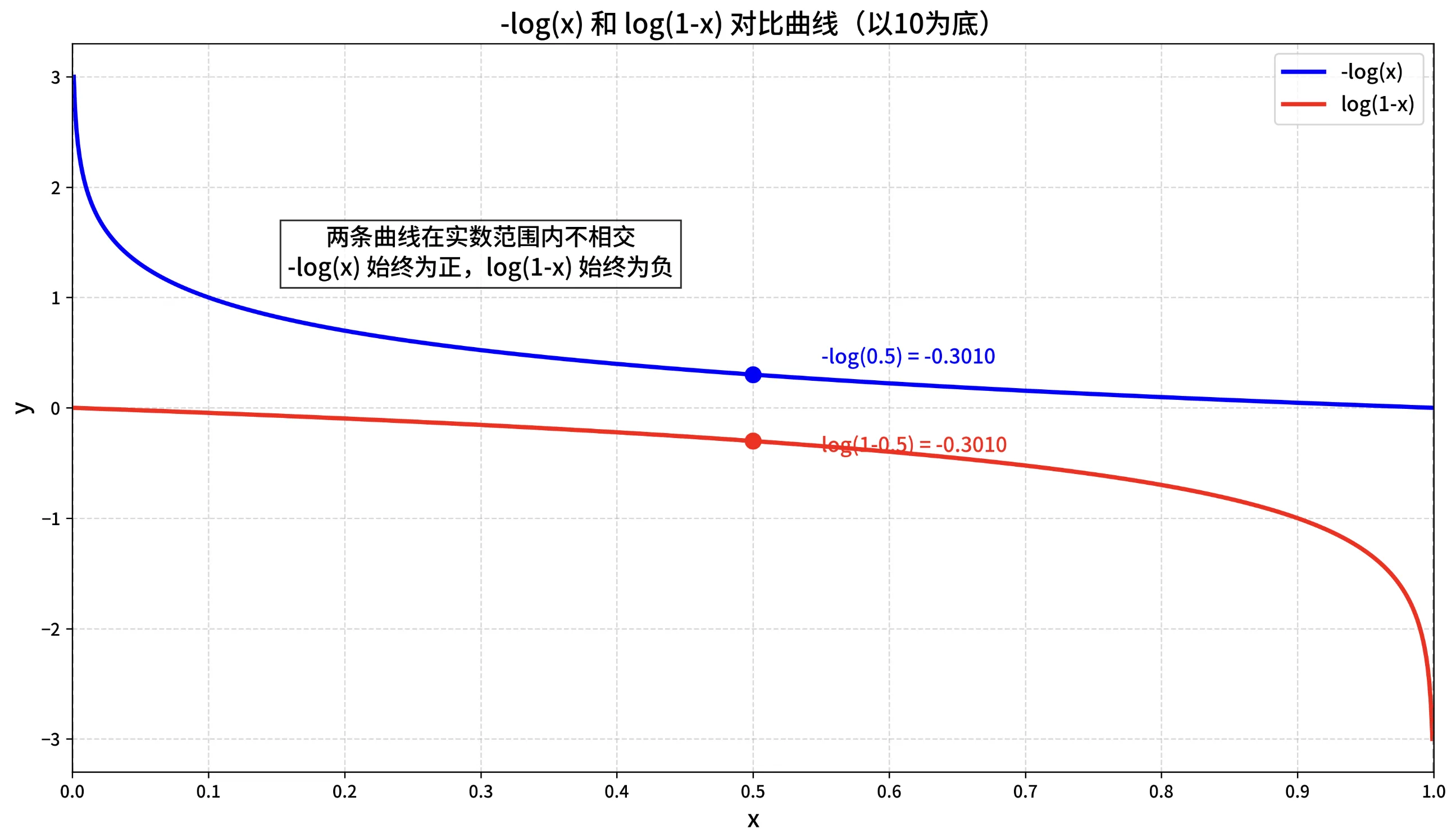
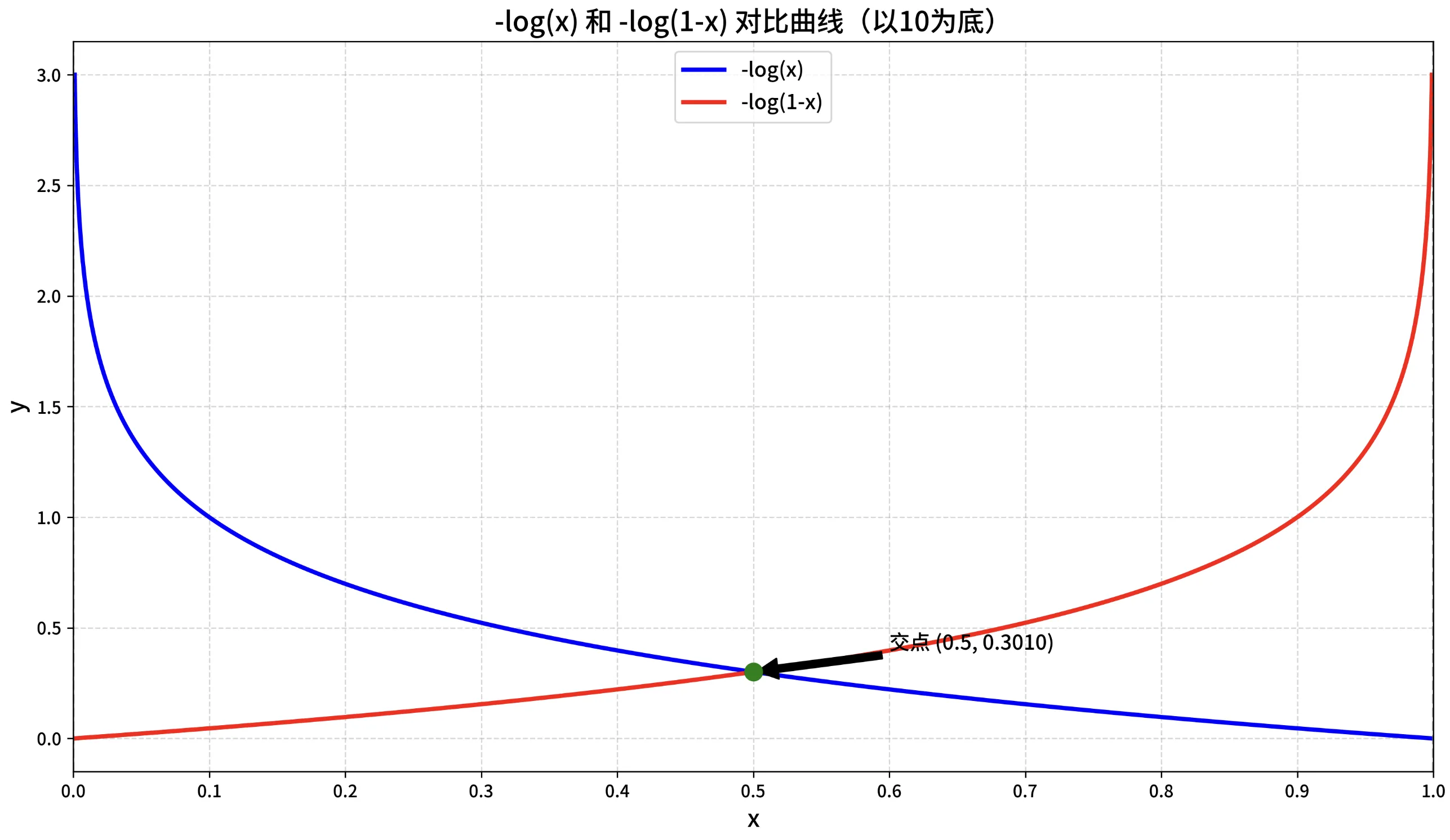
简化交叉熵损失函数

为什么要用这个函数来表示?来源自 最大释然估计(Maximum Likelihood),这里不做过多介绍。
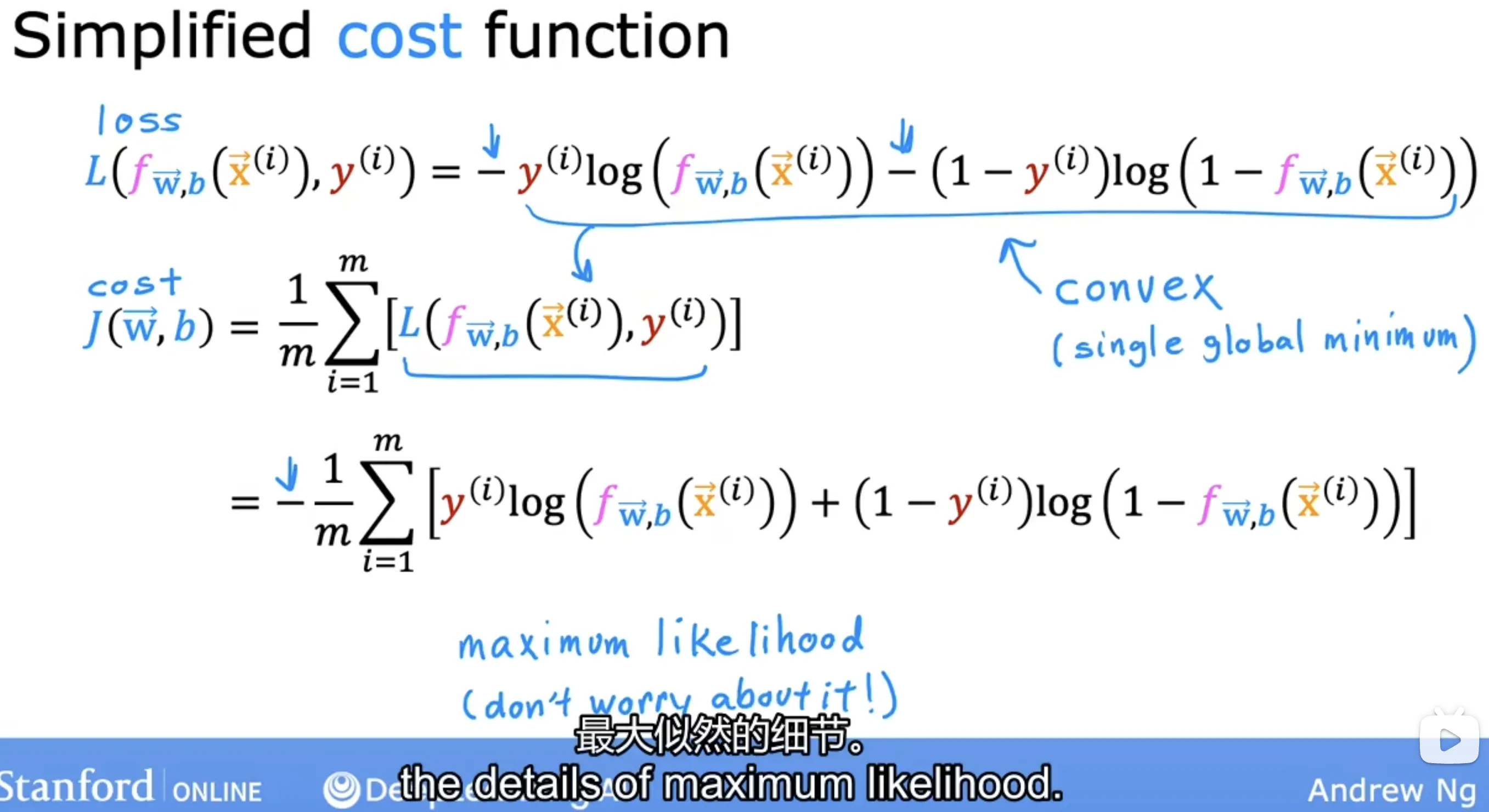
简化结果:
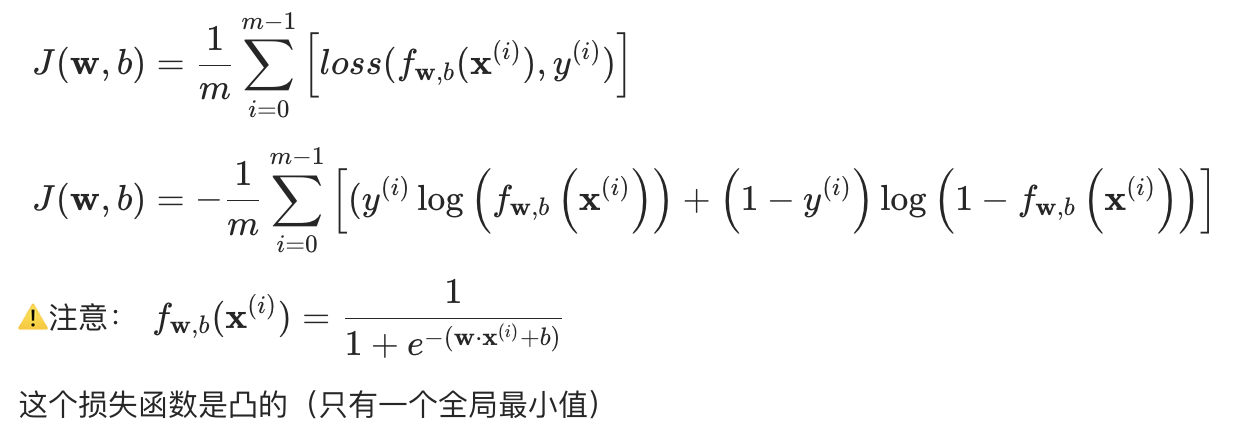
逻辑回归的梯度计算
自然对数求导公式:
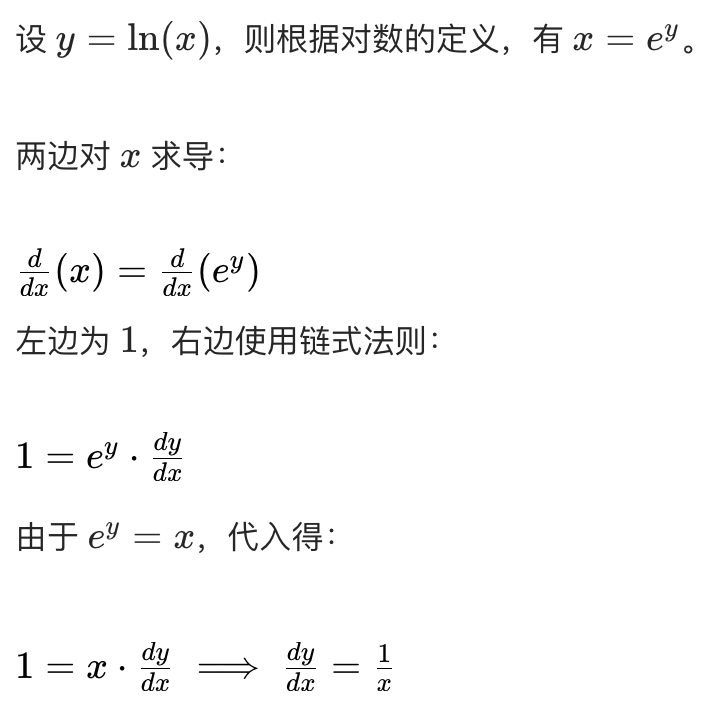
链式求导法则:
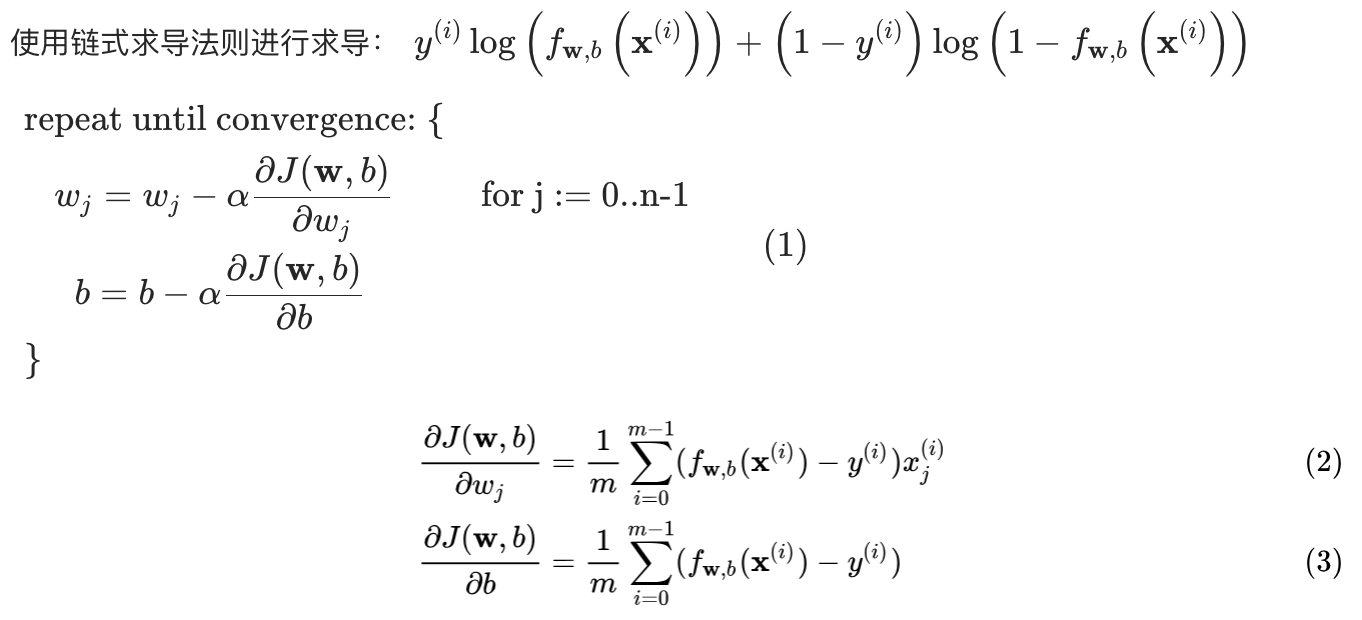
⚠️注意:
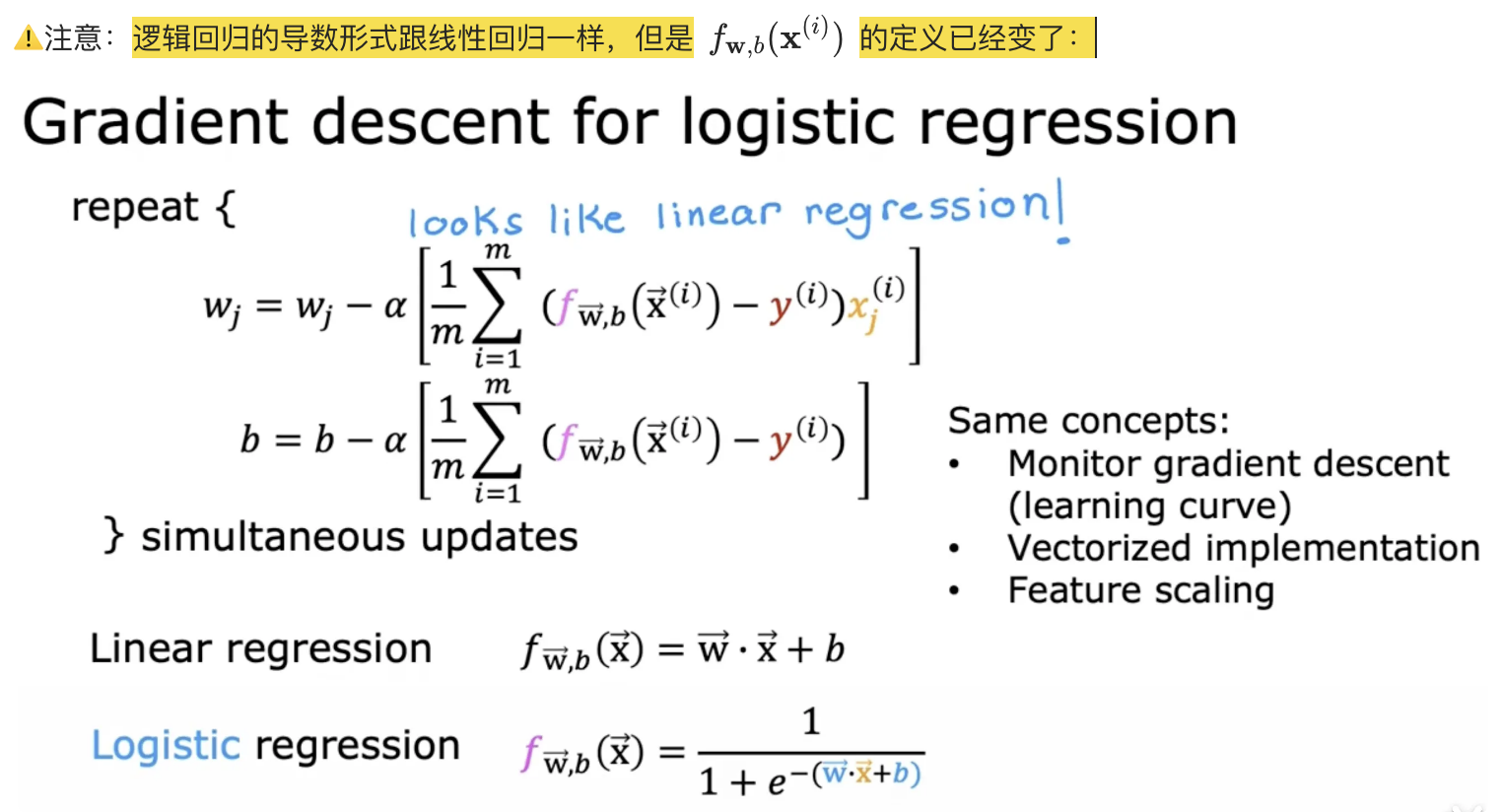
过拟合问题
线性回归过拟合
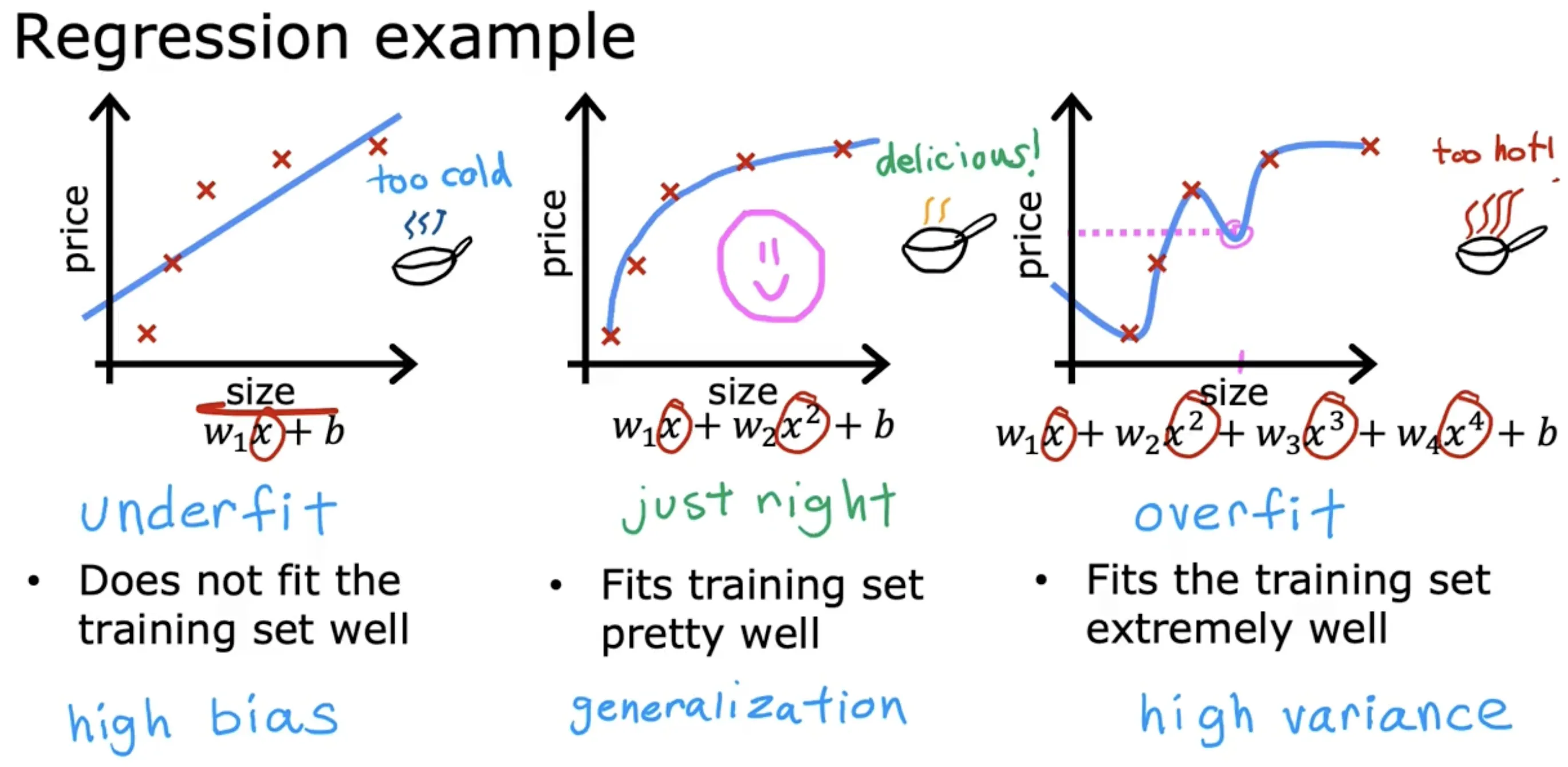
逻辑回归过拟合
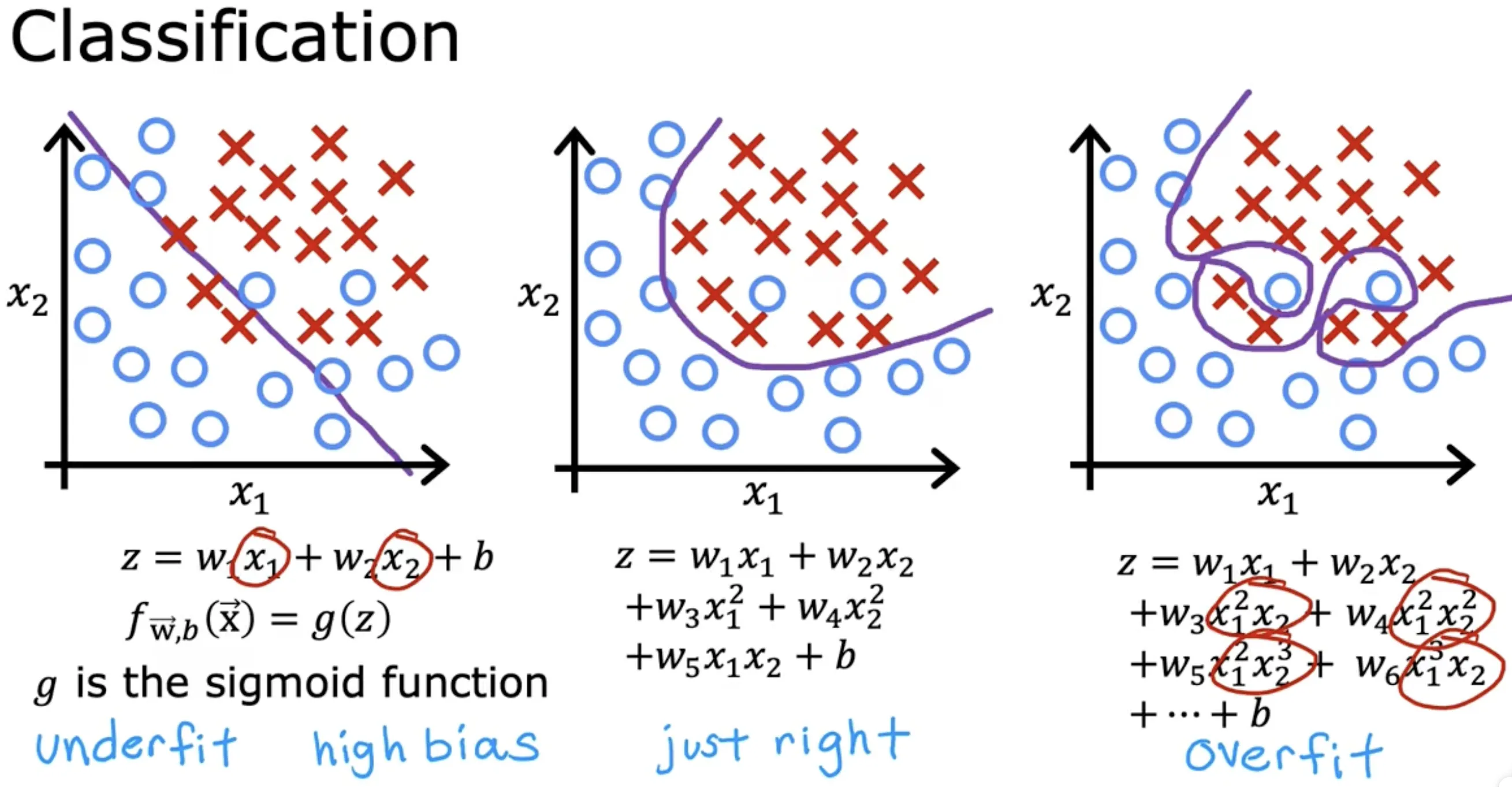
- 欠拟合(underfit),存在高偏差(bias)
- 泛化(generalization):希望我们的学习算法在训练集之外的数据上也能表现良好(预测准确)
- 过拟合(overfit),存在高方差(variance)
解决过拟合的办法
- 特征选择:只选择部分最相关的特征(基于直觉intuition)进行训练;缺点是丢掉了部分可能有用的信息
- 正则化:正则化是一种更温和的减少某些特征的影响,而无需做像测地消除它那样苛刻的事:
- 鼓励学习算法缩小参数,而不是直接将参数设置为0(保留所有特征的同时避免让部分特征产生过大的影响)
- 鼓励把 w1 ~ wn 变小,b不用变小
正则化模型
It turns out that regularization is a way
to more gently reduce ths impacts of some of the features without doing something as harsh as eliminating it outright.

关于正则化项的说明:

带正则化项的损失函数
正则化线性回归
损失函数:

梯度计算:
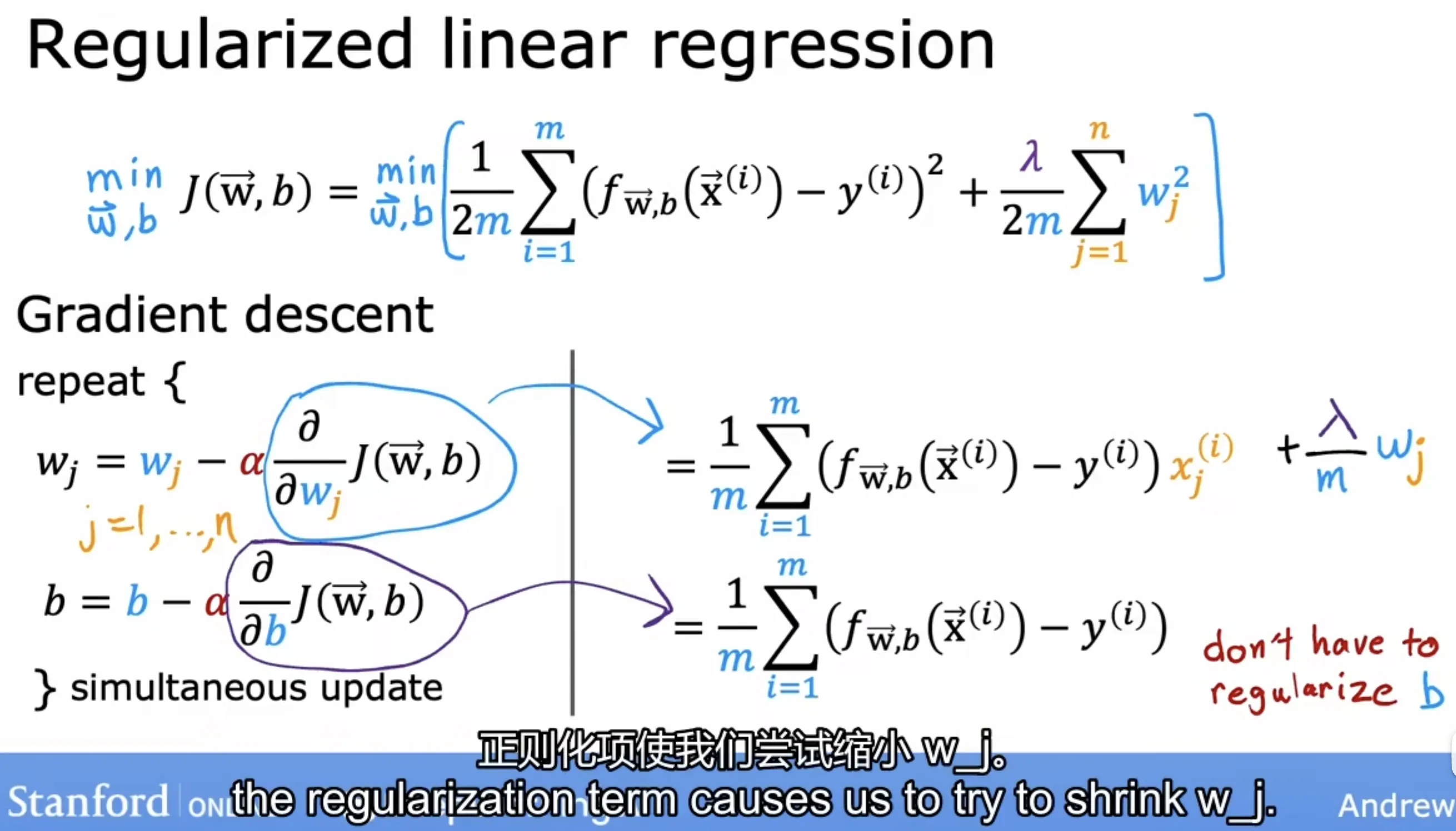
分析梯度计算公式,由于alpha和lambda通常是很小的值,所以相当于在每次迭代之前把参数w缩小了一点点,这也就是正则化的工作原理,如下所示:
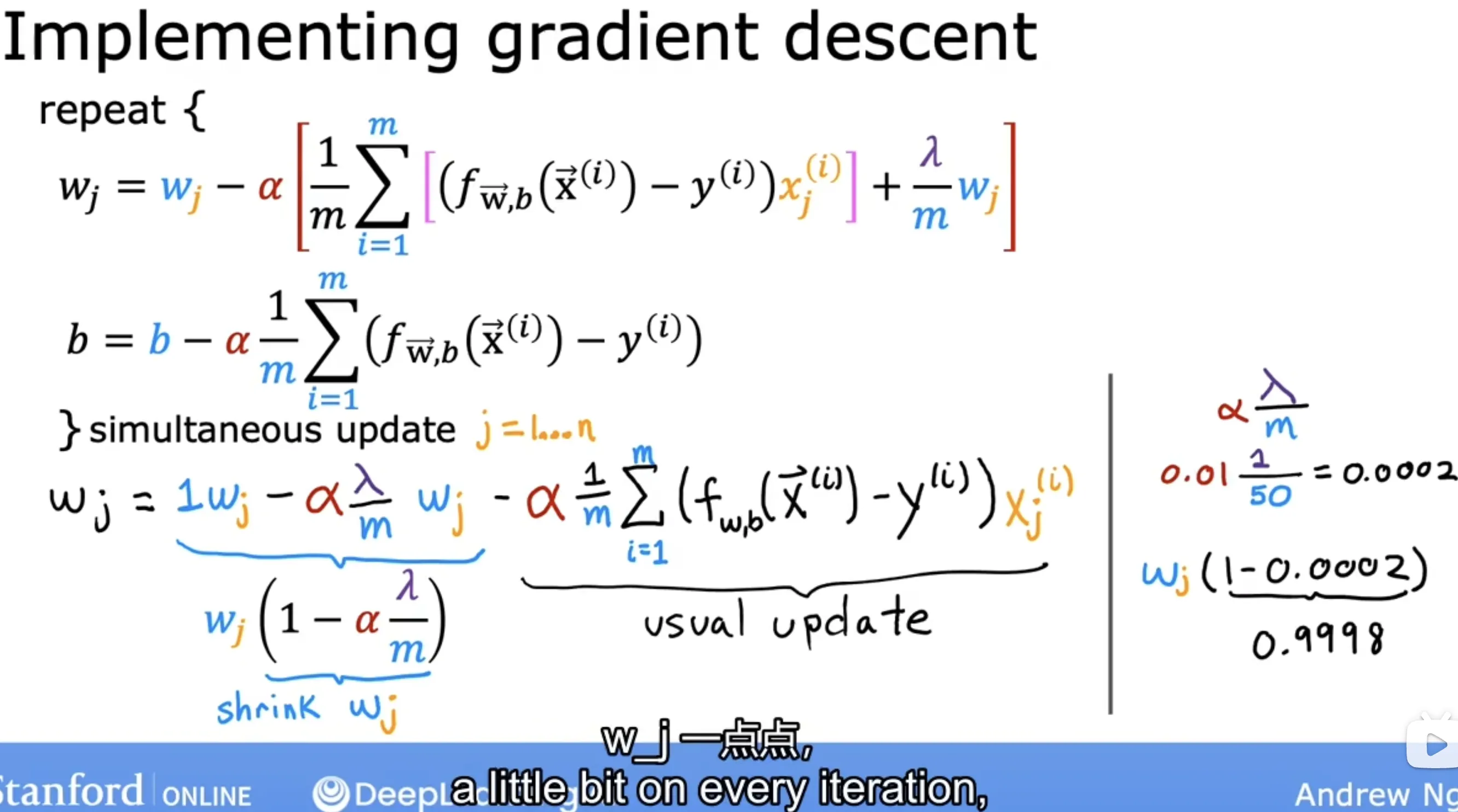
正则化逻辑回归
损失函数:

梯度计算:
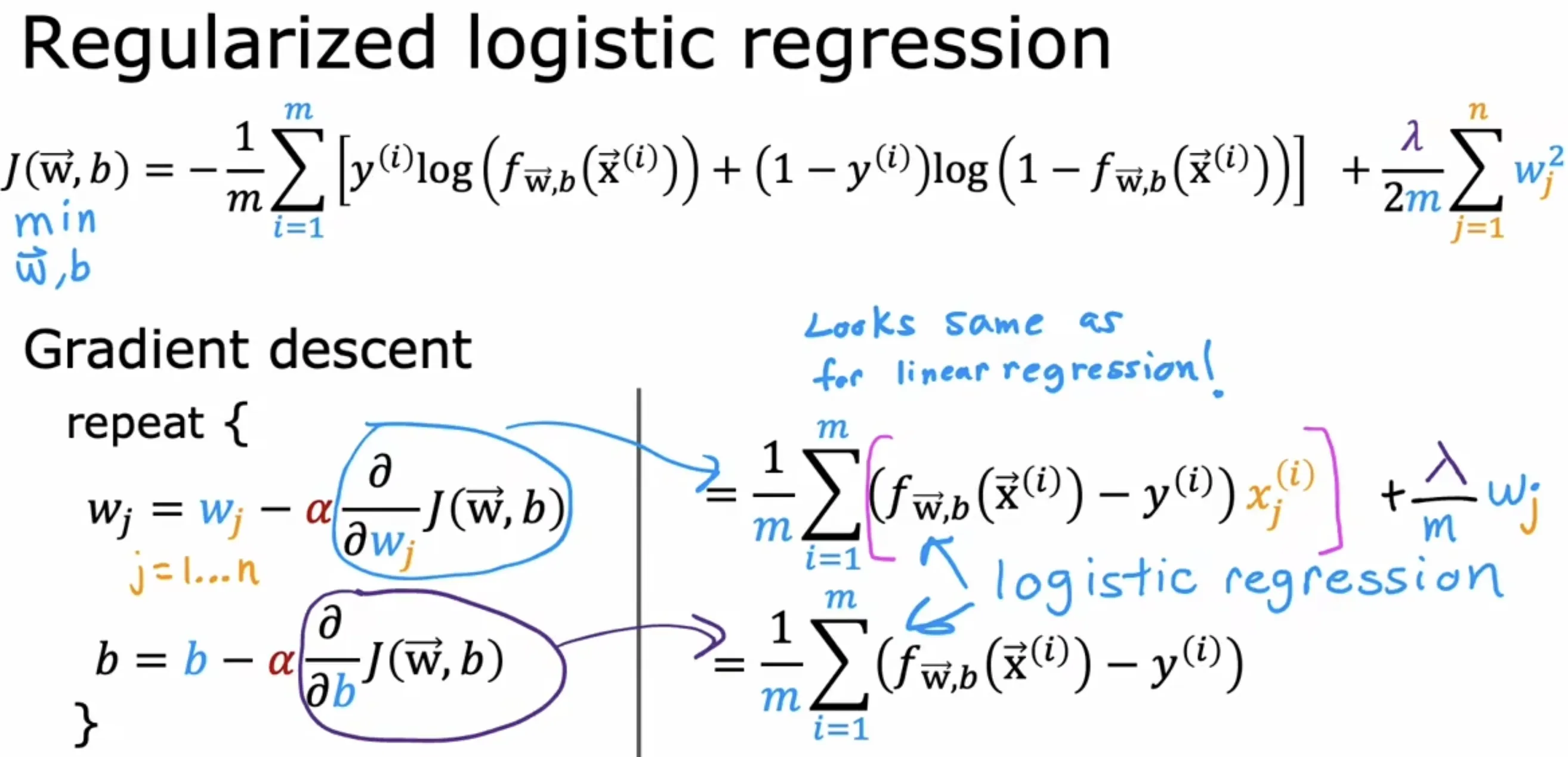
线性回归和逻辑回归正则化总结
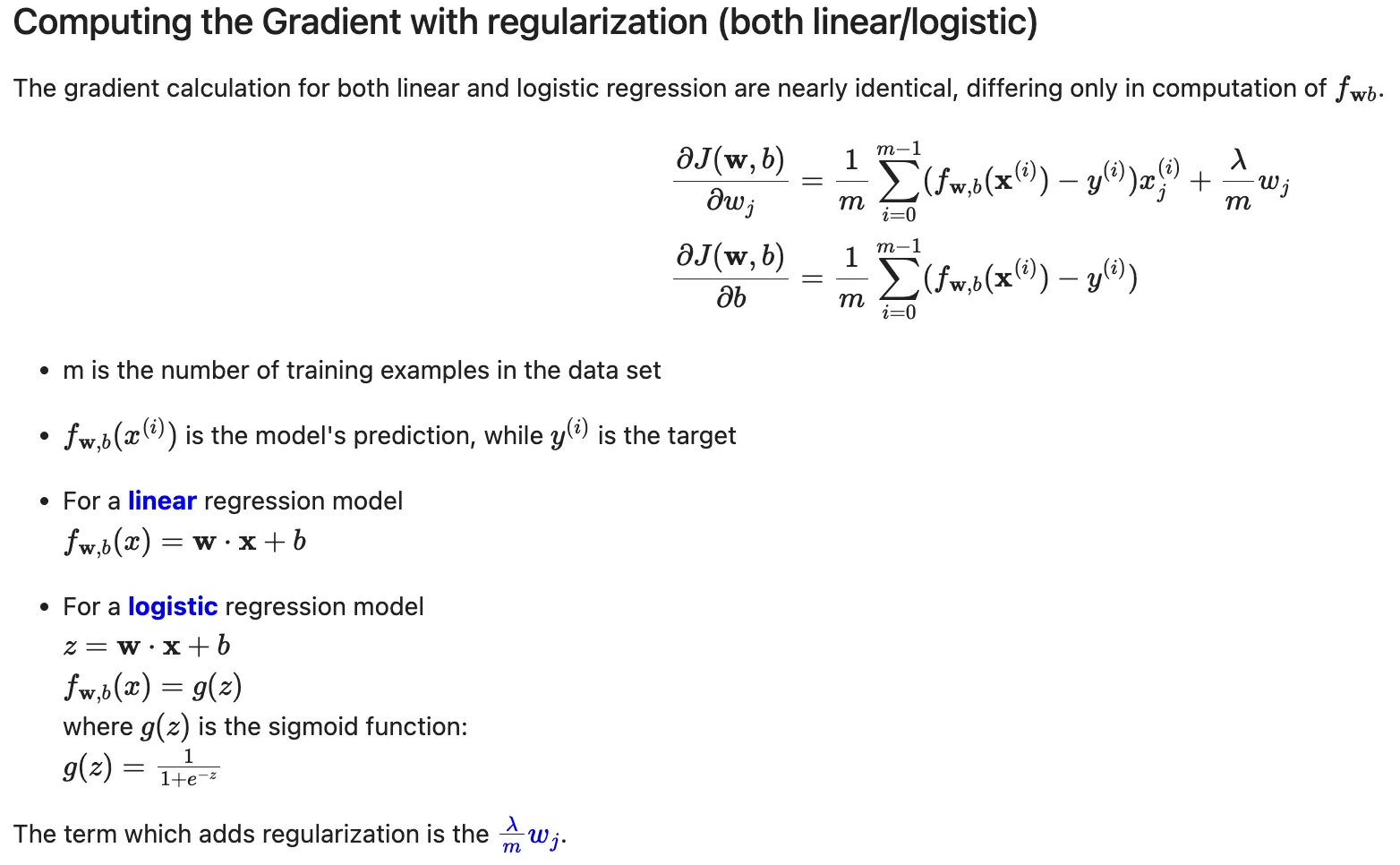
逻辑回归实战
模型选择
可视化训练数据,基于此数据选择线性逻辑回归模型
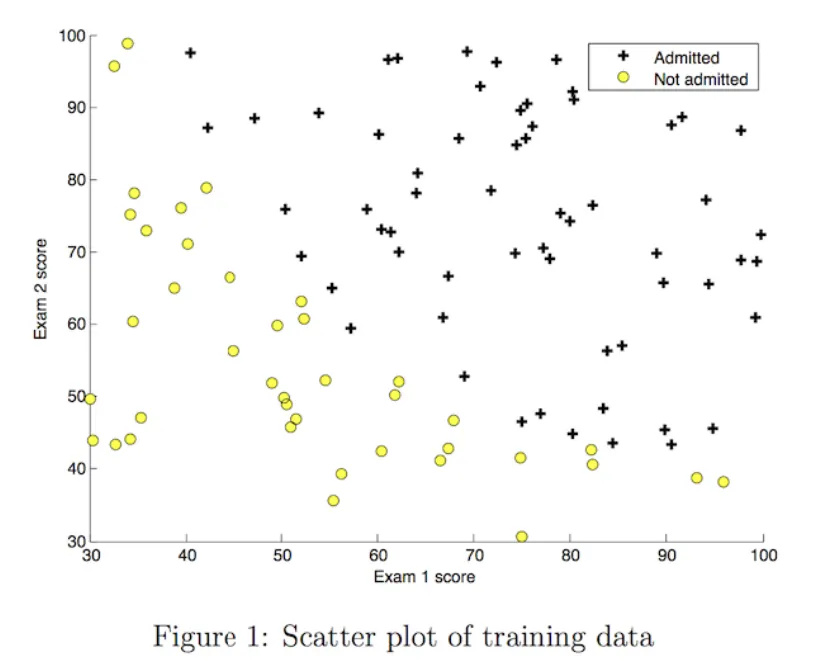
关键代码实现
|
1
2
3
4
5
6
7
8
9
10
11
12
13
14
15
16
17
18
19
20
21
22
23
24
25
26
27
28
29
30
31
32
33
34
35
36
37
38
39
40
41
42
43
44
45
46
47
48
49
50
51
52
53
54
55
56
57
58
59
60
61
62
63
64
65
66
67
68
69
70
71
72
73
74
75
76
77
78
79
80
81
82
83
84
85
86
87
88
89
90
91
92
93
94
95
96
97
98
99
100
101
102
103
104
105
106
107
108
109
|
def
sigmoid(z):
g
=
1
/
(
1
+
np.exp(
-
z))
return
g
def
compute_cost(X, y, w, b, lambda_
=
1
):
"""
Computes the cost over all examples
Args:
X : (ndarray Shape (m,n)) data, m examples by n features
y : (array_like Shape (m,)) target value
w : (array_like Shape (n,)) Values of parameters of the model
b : scalar Values of bias parameter of the model
lambda_: unused placeholder
Returns:
total_cost: (scalar) cost
"""
m, n
=
X.shape
total_cost
=
0
for
i
in
range
(m):
f_wb_i
=
sigmoid(np.dot(X[i], w)
+
b)
loss
=
-
y[i]
*
np.log(f_wb_i)
-
(
1
-
y[i])
*
np.log(
1
-
f_wb_i)
total_cost
+
=
loss
total_cost
=
total_cost
/
m
return
total_cost
def
compute_gradient(X, y, w, b, lambda_
=
None
):
"""
Computes the gradient for logistic regression
Args:
X : (ndarray Shape (m,n)) variable such as house size
y : (array_like Shape (m,1)) actual value
w : (array_like Shape (n,1)) values of parameters of the model
b : (scalar) value of parameter of the model
lambda_: unused placeholder.
Returns
dj_dw: (array_like Shape (n,1)) The gradient of the cost w.r.t. the parameters w.
dj_db: (scalar) The gradient of the cost w.r.t. the parameter b.
"""
m, n
=
X.shape
dj_dw
=
np.zeros(n)
dj_db
=
0.
for
i
in
range
(m):
f_wb_i
=
sigmoid(np.dot(X[i], w)
+
b)
diff
=
f_wb_i
-
y[i]
dj_db
+
=
diff
for
j
in
range
(n):
dj_dw[j]
=
dj_dw[j]
+
diff
*
X[i][j]
dj_db
=
dj_db
/
m
dj_dw
=
dj_dw
/
m
return
dj_db, dj_dw
def
gradient_descent(X, y, w_in, b_in, cost_function, gradient_function, alpha, num_iters, lambda_):
"""
Performs batch gradient descent to learn theta. Updates theta by taking
num_iters gradient steps with learning rate alpha
Args:
X : (array_like Shape (m, n)
y : (array_like Shape (m,))
w_in : (array_like Shape (n,)) Initial values of parameters of the model
b_in : (scalar) Initial value of parameter of the model
cost_function: function to compute cost
alpha : (float) Learning rate
num_iters : (int) number of iterations to run gradient descent
lambda_ (scalar, float) regularization constant
Returns:
w : (array_like Shape (n,)) Updated values of parameters of the model after
running gradient descent
b : (scalar) Updated value of parameter of the model after
running gradient descent
"""
# number of training examples
m
=
len
(X)
# An array to store cost J and w's at each iteration primarily for graphing later
J_history
=
[]
w_history
=
[]
w
=
copy.deepcopy(w_in)
b
=
b_in
for
i
in
range
(num_iters):
dj_db, dj_dw
=
gradient_function(X, y, w, b, lambda_)
w
=
w
-
alpha
*
dj_dw
b
=
b
-
alpha
*
dj_db
cost
=
cost_function(X, y, w, b, lambda_)
J_history.append(cost)
w_history.append(w)
if
i
%
math.ceil(num_iters
/
10
)
=
=
0
:
print
(f
"{i:4d} cost: {cost:6f}, w: {w}, b: {b}"
)
return
w, b, J_history, w_history
#return w and J,w history for graphing
def
predict(X, w, b):
m, n
=
X.shape
p
=
np.zeros(m)
for
i
in
range
(m):
f_wb
=
sigmoid(np.dot(X[i], w)
+
b)
p[i]
=
f_wb >
=
0.5
return
p
|
结果展示
|
1
2
3
4
5
6
7
8
9
10
11
12
13
14
15
16
17
18
19
20
21
22
23
24
25
26
27
28
29
30
31
32
33
34
35
36
37
38
39
40
41
42
43
44
45
46
47
48
49
50
51
52
53
54
55
56
|
import
numpy as np
import
matplotlib.pyplot as plt
import
matplotlib.font_manager as fm
# 支持显示中文
font_path
=
'/System/Library/Fonts/STHeiti Light.ttc'
custom_font
=
fm.FontProperties(fname
=
font_path)
plt.rcParams[
"font.family"
]
=
custom_font.get_name()
# 载入训练集
X_train, y_train
=
load_data(
"data/ex2data1.txt"
)
# 训练模型
np.random.seed(
1
)
intial_w
=
0.01
*
(np.random.rand(
2
).reshape(
-
1
,
1
)
-
0.5
)
initial_b
=
-
8
iterations
=
10000
alpha
=
0.001
w_out, b_out, J_history,_
=
gradient_descent(X_train ,y_train, initial_w, initial_b, compute_cost, compute_gradient, alpha, iterations,
0
)
# 根据训练结果(w_out和b_out)计算决策边界
#f = w0*x0 + w1*x1 + b
# x1 = -1 * (w0*x0 + b) / w1
plot_x
=
np.array([
min
(X_train[:,
0
]),
max
(X_train[:,
0
])])
plot_y
=
(
-
1.
/
w_out[
1
])
*
(w_out[
0
]
*
plot_x
+
b_out)
# 将训练数据分类
x0s_pos
=
[]
x1s_pos
=
[]
x0s_neg
=
[]
x1s_neg
=
[]
for
i
in
range
(
len
(X_train)):
x
=
X_train[i]
# print(x)
y_i
=
y_train[i]
if
y_i
=
=
1
:
x0s_pos.append(x[
0
])
x1s_pos.append(x[
1
])
else
:
x0s_neg.append(x[
0
])
x1s_neg.append(x[
1
])
# 绘图
plt.figure(figsize
=
(
8
,
6
))
plt.scatter(x0s_pos, x1s_pos, marker
=
'o'
, c
=
'green'
, label
=
"Admitted"
)
plt.scatter(x0s_neg, x1s_neg, marker
=
'x'
, c
=
'red'
, label
=
"Not admitted"
)
plt.plot(plot_x, plot_y, lw
=
1
, label
=
"决策边界"
)
plt.xlabel(
'Exam 1 score'
, fontsize
=
12
)
plt.ylabel(
'Exam 2 score'
, fontsize
=
12
)
plt.title(
'在二维平面上可视化分类模型的决策边界'
, fontsize
=
14
)
plt.legend(fontsize
=
12
, loc
=
'upper center'
)
plt.grid(
True
)
plt.show()
# 使用训练集计算预测准确率
p
=
predict(X_train, w_out, b_out)
print
(
'Train Accuracy: %f'
%
(np.mean(p
=
=
y_train)
*
100
))
# Train Accuracy: 92.000000
|
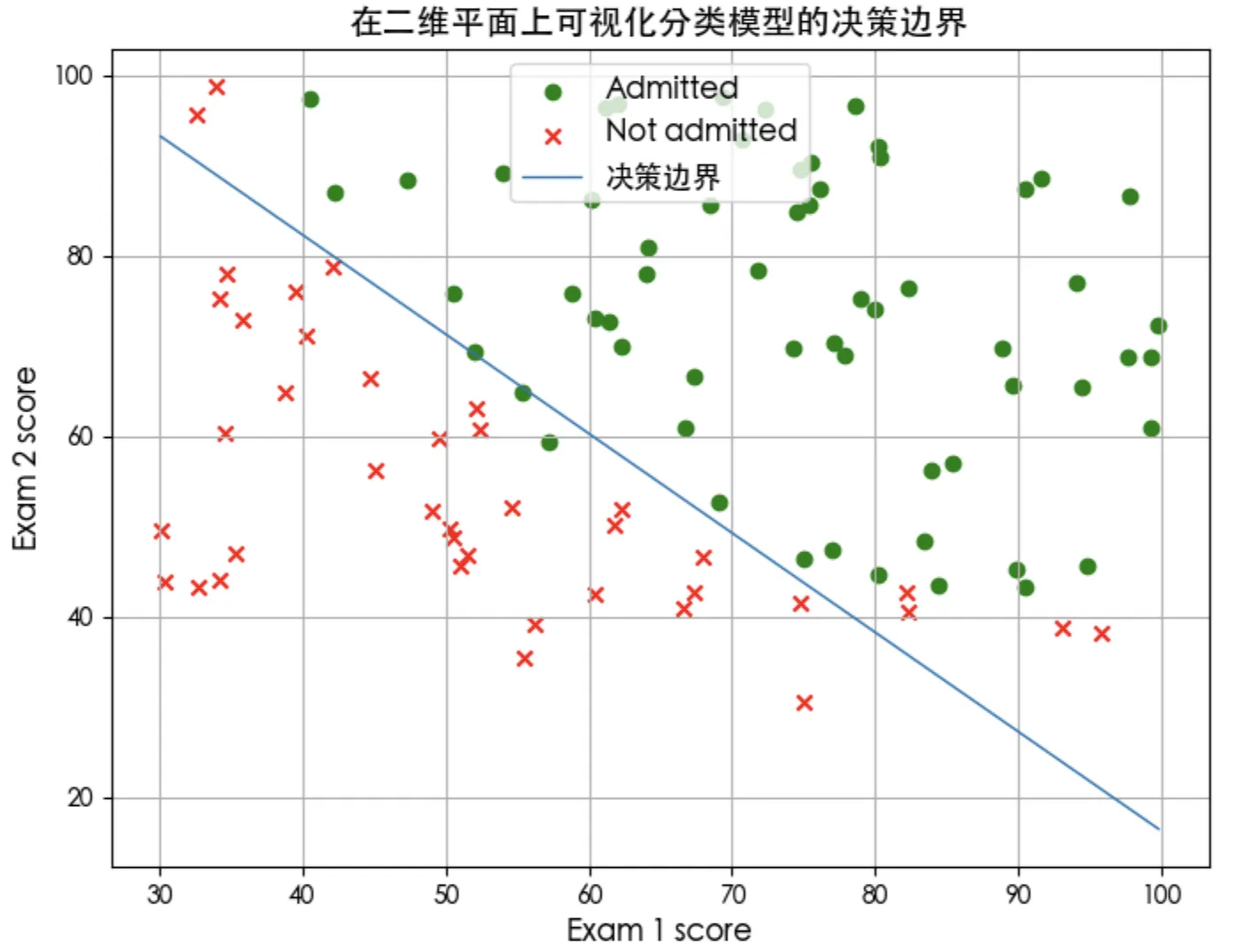
正则化逻辑回归实战
模型选择
可视化训练数据,基于此数据选择多项式逻辑回归模型
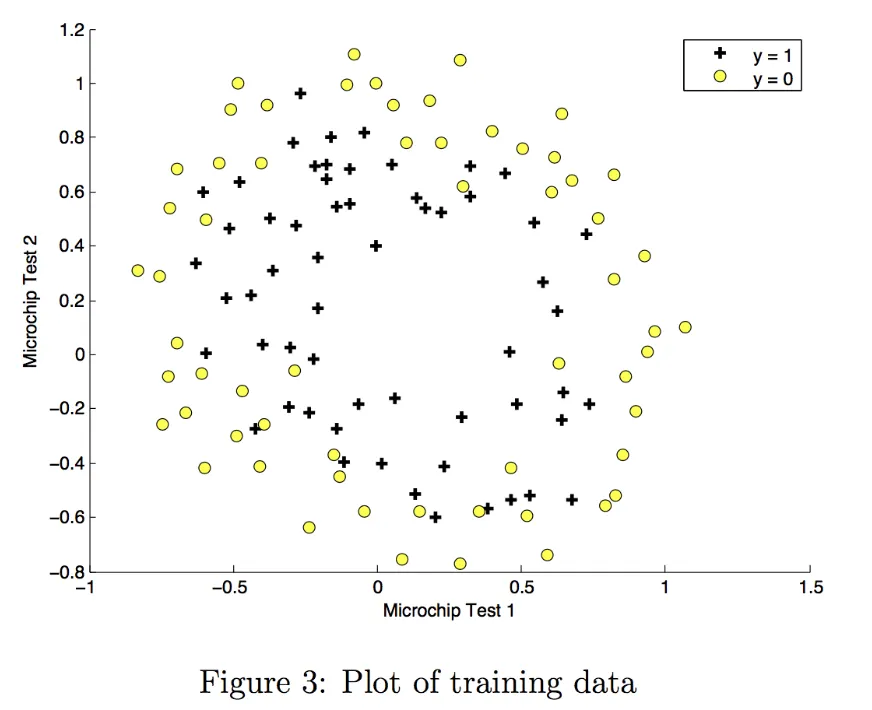
关键代码实现
由于要拟合非线性决策边界,所以要增加特征的复杂度(训练数据里只有2个特征)。
特征映射函数
|
1
2
3
4
5
6
7
8
9
10
11
12
13
14
|
# 将输入特征 X1 和 X2 转换为六次多项式特征
# 这个函数常用于逻辑回归或支持向量机等模型中,通过增加特征的复杂度来拟合非线性决策边界。
def
map_feature(X1, X2):
"""
Feature mapping function to polynomial features
"""
X1
=
np.atleast_1d(X1)
X2
=
np.atleast_1d(X2)
degree
=
6
out
=
[]
for
i
in
range
(
1
, degree
+
1
):
for
j
in
range
(i
+
1
):
out.append((X1
*
*
(i
-
j)
*
(X2
*
*
j)))
return
np.stack(out, axis
=
1
)
|
正则化后的损失函数和梯度计算函数
|
1
2
3
4
5
6
7
8
9
10
11
12
13
14
15
16
17
18
19
20
21
22
23
24
25
26
27
28
29
30
31
32
33
34
35
36
37
38
39
40
41
42
43
44
45
46
47
48
49
|
def
compute_cost_reg(X, y, w, b, lambda_
=
1
):
"""
Computes the cost over all examples
Args:
X : (array_like Shape (m,n)) data, m examples by n features
y : (array_like Shape (m,)) target value
w : (array_like Shape (n,)) Values of parameters of the model
b : (array_like Shape (n,)) Values of bias parameter of the model
lambda_ : (scalar, float) Controls amount of regularization
Returns:
total_cost: (scalar) cost
"""
m, n
=
X.shape
# Calls the compute_cost function that you implemented above
cost_without_reg
=
compute_cost(X, y, w, b)
reg_cost
=
0.
for
j
in
range
(n):
reg_cost
+
=
w[j]
*
*
2
# Add the regularization cost to get the total cost
total_cost
=
cost_without_reg
+
(lambda_
/
(
2
*
m))
*
reg_cost
return
total_cost
def
compute_gradient_reg(X, y, w, b, lambda_
=
1
):
"""
Computes the gradient for linear regression
Args:
X : (ndarray Shape (m,n)) variable such as house size
y : (ndarray Shape (m,)) actual value
w : (ndarray Shape (n,)) values of parameters of the model
b : (scalar) value of parameter of the model
lambda_ : (scalar,float) regularization constant
Returns
dj_db: (scalar) The gradient of the cost w.r.t. the parameter b.
dj_dw: (ndarray Shape (n,)) The gradient of the cost w.r.t. the parameters w.
"""
m, n
=
X.shape
dj_db, dj_dw
=
compute_gradient(X, y, w, b)
# Add the regularization
for
j
in
range
(n):
dj_dw[j]
+
=
(lambda_
/
m)
*
w[j]
return
dj_db, dj_dw
|
结果展示
|
1
2
3
4
5
6
7
8
9
10
11
12
13
14
15
16
17
18
19
20
21
22
23
24
25
26
27
28
29
30
31
32
33
34
35
36
37
38
39
40
41
42
43
44
45
46
47
48
49
50
51
52
53
54
55
56
57
58
59
60
61
62
63
64
65
66
67
68
69
70
71
72
73
74
75
76
|
import
numpy as np
import
matplotlib.pyplot as plt
import
matplotlib.font_manager as fm
# 支持显示中文
font_path
=
'/System/Library/Fonts/STHeiti Light.ttc'
custom_font
=
fm.FontProperties(fname
=
font_path)
plt.rcParams[
"font.family"
]
=
custom_font.get_name()
# 载入训练集
X_train, y_train
=
load_data(
"data/ex2data2.txt"
)
# 通过增加特征的复杂度来拟合非线性决策边界
X_mapped
=
map_feature(X_train[:,
0
], X_train[:,
1
])
print
(
"Original shape of data:"
, X_train.shape)
print
(
"Shape after feature mapping:"
, X_mapped.shape)
# 训练模型
np.random.seed(
1
)
initial_w
=
np.random.rand(X_mapped.shape[
1
])
-
0.5
initial_b
=
1.
# Set regularization parameter lambda_ to 1 (you can try varying this)
lambda_
=
0.5
iterations
=
10000
alpha
=
0.01
w_out, b_out, J_history, _
=
gradient_descent(X_mapped, y_train, initial_w, initial_b, compute_cost_reg, compute_gradient_reg, alpha, iterations, lambda_)
# 根据训练结果(w_out和b_out)计算决策边界
# - 创建网格点 u 和 v 覆盖特征空间
u
=
np.linspace(
-
1
,
1.5
,
50
)
v
=
np.linspace(
-
1
,
1.5
,
50
)
# - 计算每个网格点处的预测概率 z
z
=
np.zeros((
len
(u),
len
(v)))
# Evaluate z = theta*x over the grid
for
i
in
range
(
len
(u)):
for
j
in
range
(
len
(v)):
z[i,j]
=
sig(np.dot(map_feature(u[i], v[j]), w_out)
+
b_out)
# - 转置 z 是必要的,因为contour函数期望的输入格式与我们的计算顺序不一致
z
=
z.T
# 分类
x0s_pos
=
[]
x1s_pos
=
[]
x0s_neg
=
[]
x1s_neg
=
[]
for
i
in
range
(
len
(X_train)):
x
=
X_train[i]
# print(x)
y_i
=
y_train[i]
if
y_i
=
=
1
:
x0s_pos.append(x[
0
])
x1s_pos.append(x[
1
])
else
:
x0s_neg.append(x[
0
])
x1s_neg.append(x[
1
])
# 绘图
plt.figure(figsize
=
(
8
,
6
))
plt.scatter(x0s_pos, x1s_pos, marker
=
'o'
, c
=
'black'
, label
=
"y=1"
)
plt.scatter(x0s_neg, x1s_neg, marker
=
'x'
, c
=
'orange'
, label
=
"y=0"
)
# 绘制决策边界(等高线)
plt.contour(u,v,z, levels
=
[
0.5
], colors
=
"green"
)
# 创建虚拟线条用于图例(颜色和线型需与等高线一致)
plt.plot([], [], color
=
'green'
, label
=
"决策边界"
)
plt.xlabel(
'Test 1'
, fontsize
=
12
)
plt.ylabel(
'Test 2'
, fontsize
=
12
)
plt.title(
'正则化逻辑回归模型分类效果可视化(lambda=0.5)'
, fontsize
=
14
)
# plt.legend(fontsize=12, loc='upper center')
plt.legend(fontsize
=
12
)
plt.grid(
True
)
plt.show()
#Compute accuracy on the training set
p
=
predict(X_mapped, w_out, b_out)
print
(
'Train Accuracy: %f'
%
(np.mean(p
=
=
y_train)
*
100
))
# Train Accuracy: 83.050847
|
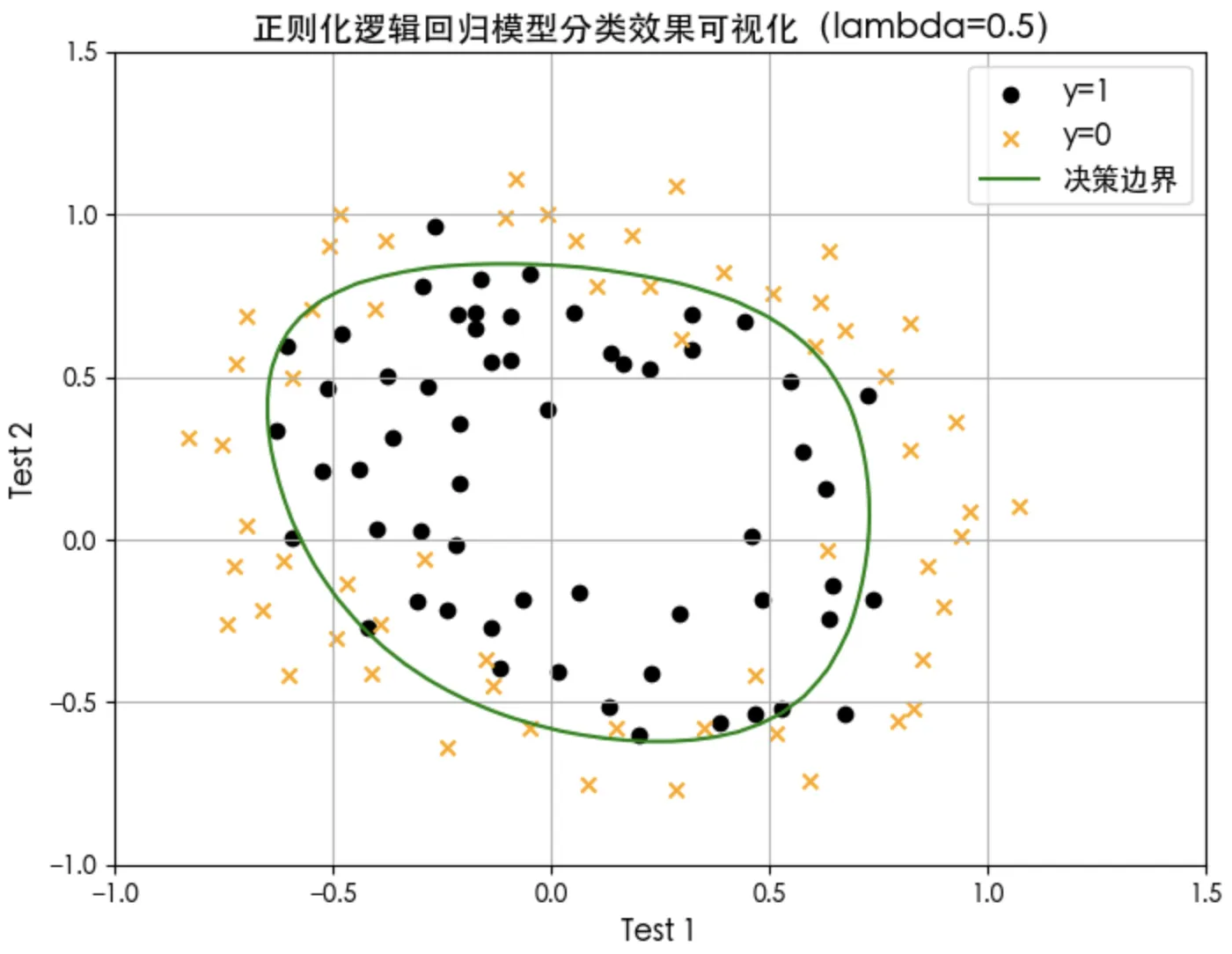
正则化效果对比
正则化对损失和决策边界的影响
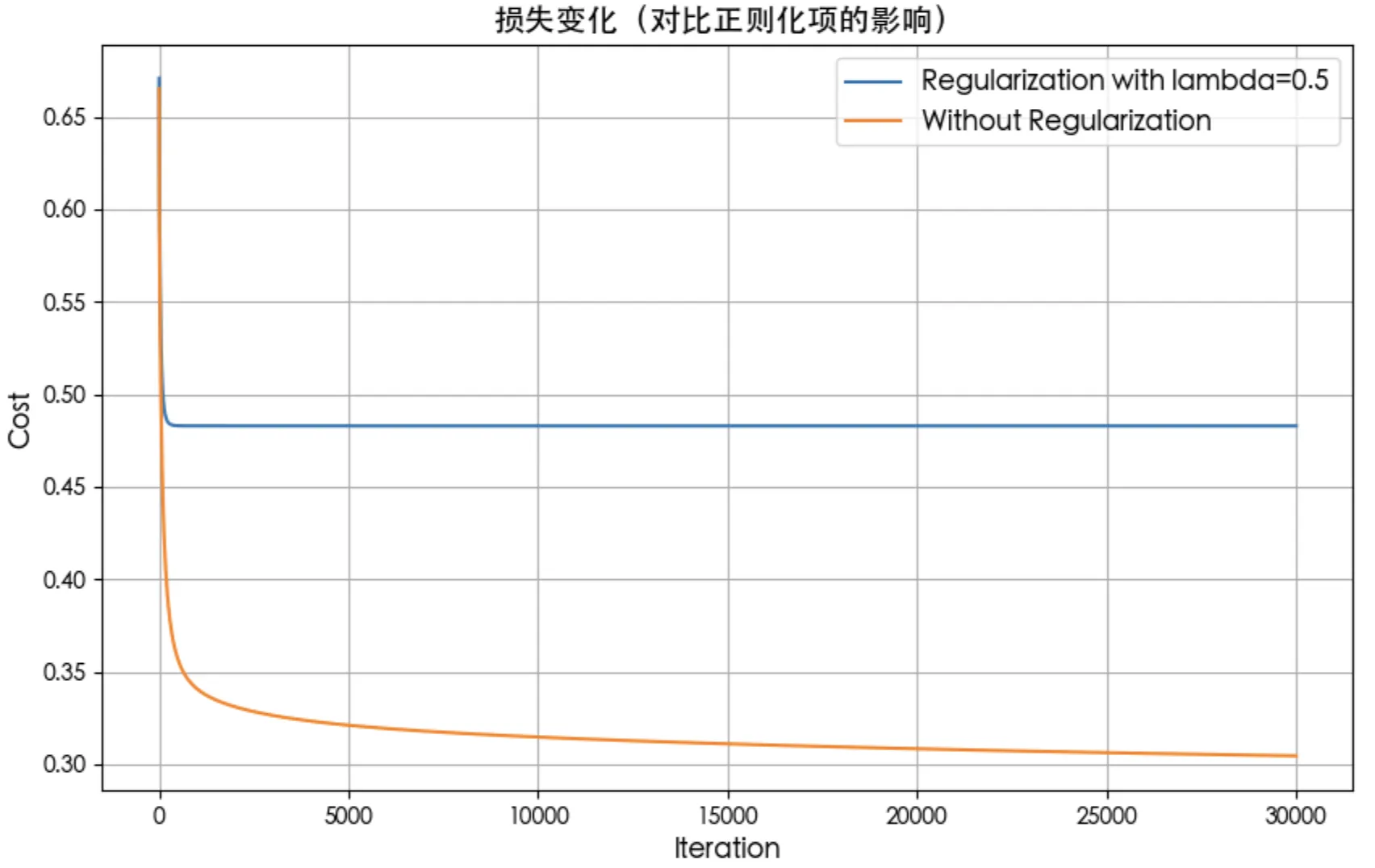
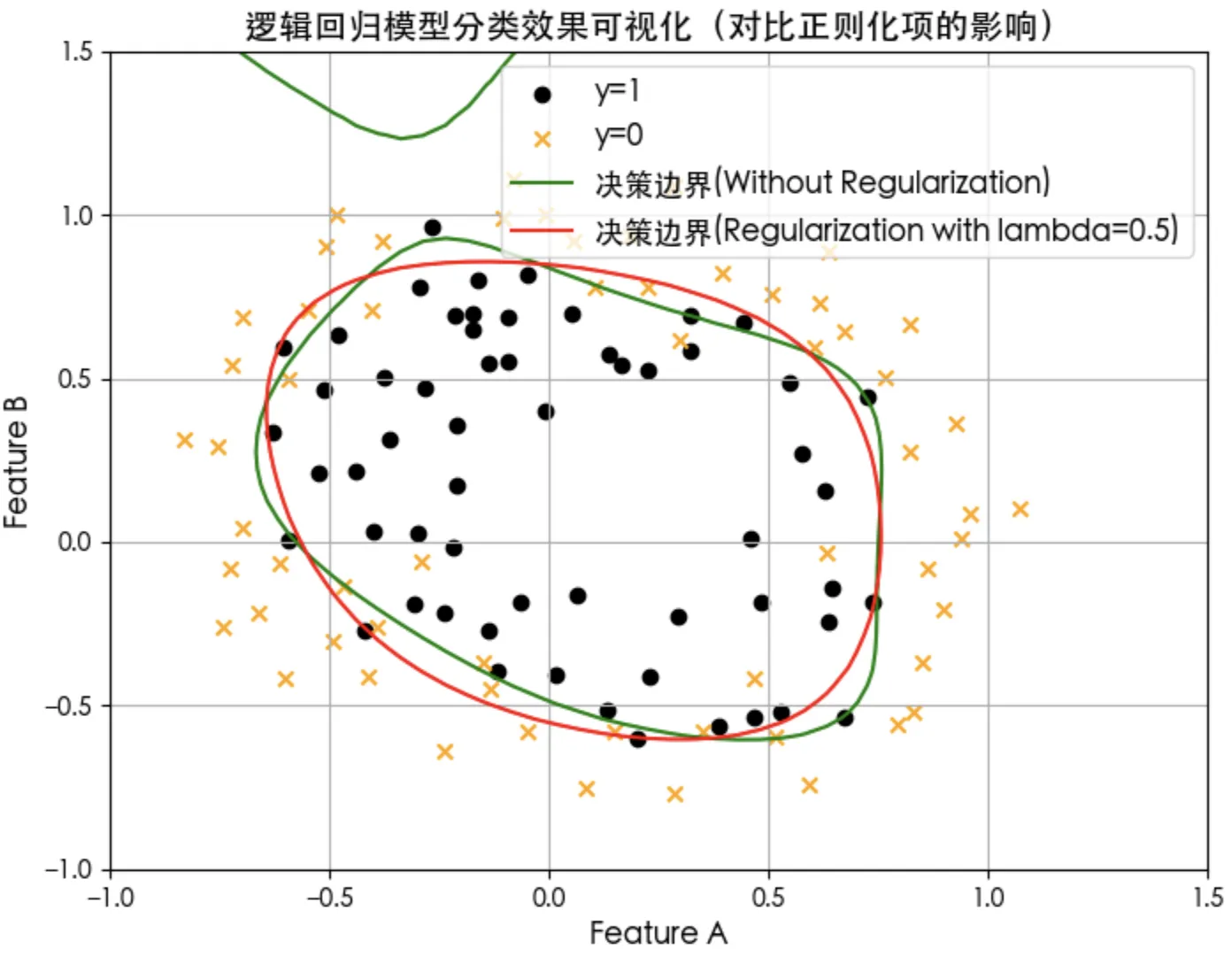
正则化项lambda参数大小对决策边界的影响
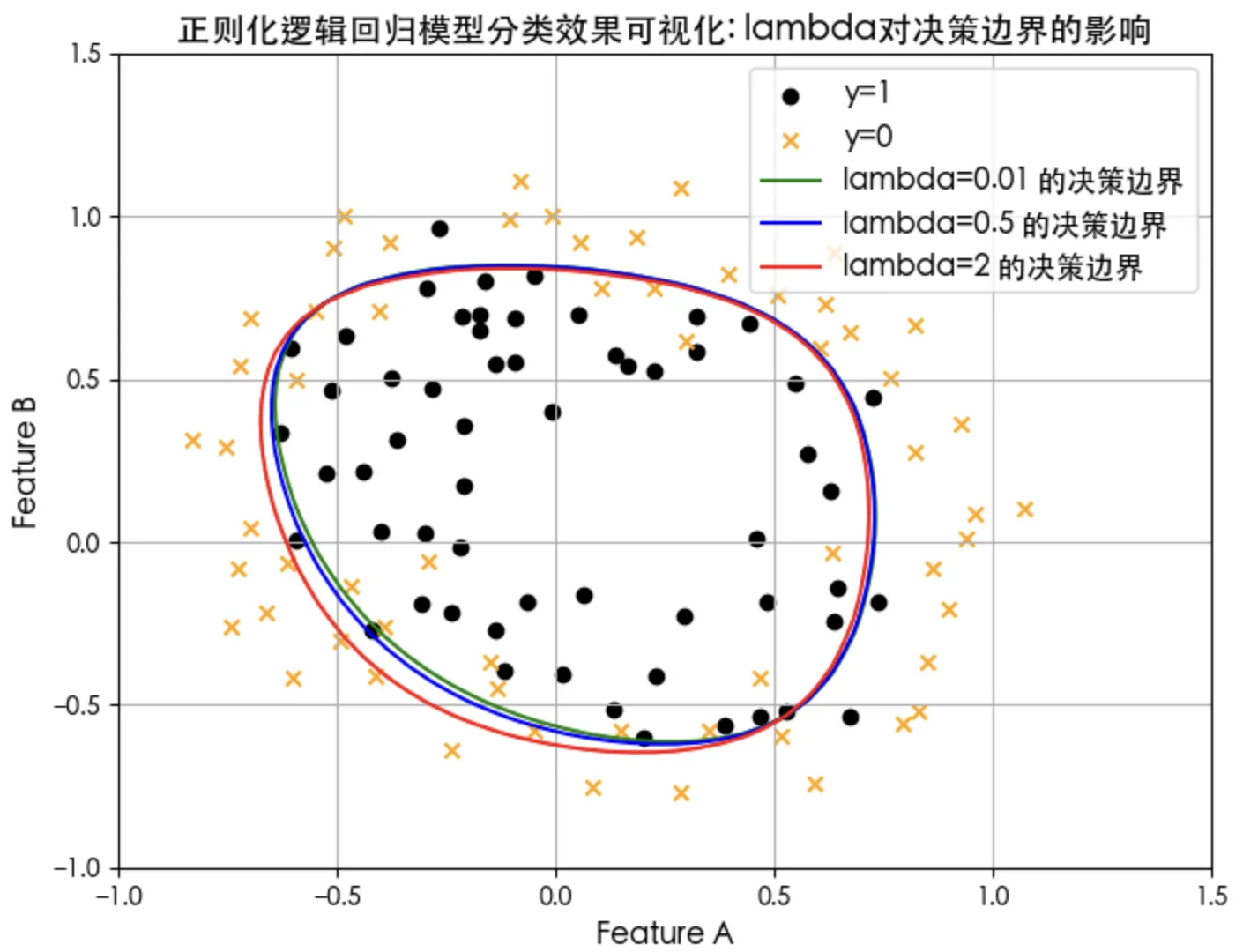
参考
吴恩达团队在Coursera开设的机器学习课程:https://www.coursera.org/specializations/machine-learning-introduction
在B站学习:https://www.bilibili.com/video/BV1Pa411X76s
原创作者: standby 转载于: https://www.cnblogs.com/standby/p/18992893




















 1万+
1万+

 被折叠的 条评论
为什么被折叠?
被折叠的 条评论
为什么被折叠?








